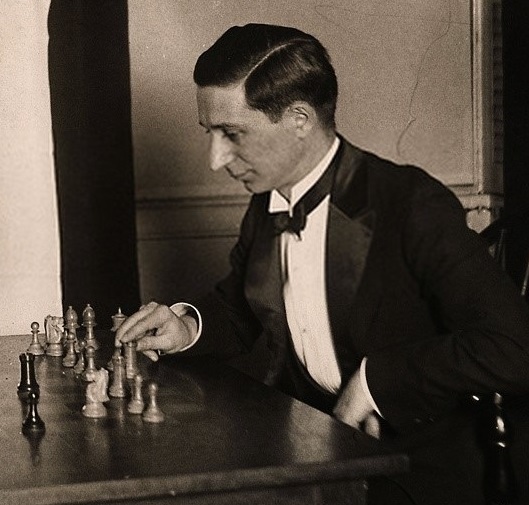
Edward Winter

Edward Lasker. See C.N. 6552 below.
***
From the privately distributed 1994 edition of Chess Personalia by Jeremy Gaige:
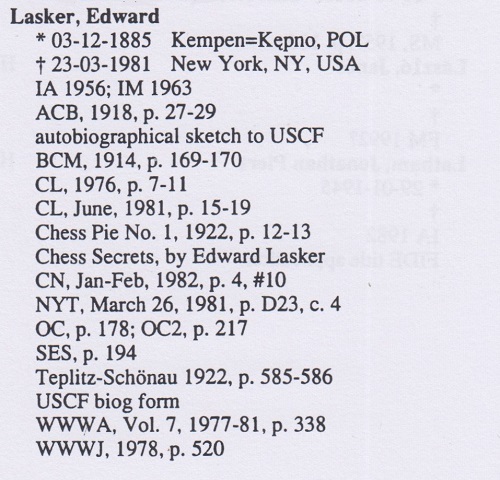
‘Edward J. Lasker’ is sometimes seen (e.g. page 206 of the April 1919 Chess Amateur). J. for what?
(94)
On the subject of a stray J., page 46 of Roberto Grau, el maestro by G.C. Grau, J.R. Delfino and J. Morgado (Buenos Aires, 2007) has a quote from La Nación in 1935 which refers to ‘R.J. Fine’. C.N. 4916 discussed occurrences of ‘Samuel J. Reshevsky’.
(5666)
A quote from page 102 of J. Platz’s Chess Memoirs (Coraopolis, 1979), concerning the two Laskers:
‘... I personally witnessed when Edward came to Emanuel just to “show” him an interesting endgame position. And everybody who knew Emanuel Lasker knows that he would never ask: “Who is White and who is Black?” but go right down to the analysis of the position and get deeply involved with it. And that is how Dr Edward Lasker got a thorough analysis of a position which in reality was one of his adjourned tournament games! Emanuel Lasker never knew the truth.’
From pages 30-31 of Chess for Fun & Chess for Blood by Edward Lasker:
‘Some contestants think nothing of showing adjourned positions to stronger players and asking their advice. In fact, they have grown so accustomed to this unfair practice they are almost no longer capable of realizing that what they do is just plain cheating, whether sanctioned by usage or not.’
(747 & 811)
From The Annual Obituary 1981 (a New York publication), page 207:
[Edward Lasker competed ...] ‘against Alexander Alekhine in 1913 at an exhibition in Paris. Alekhine, who emerged the victor, described the game’s strategy as “the Vienna Game”. The next year “Lasker Minor” played “Lasker Major” at the international tournament in St Petersburg and the elder champion won the match, retaining the world championship until he was defeated in a famous battle with Capablanca in Havana in 1921.’
It is also revealed regarding Edward Lasker:
‘He witnessed the Bobby Fischer-Boris Spassky matches in Helsinki in 1972.’
(872)
On page 65 of Chess Curiosities (London, 1985) Tim Krabbé states that ‘there is only one uncontested five queen game on record’, Tresling-Benima, Winschoten, 1896. On page 8 of Chess: The Complete Self-Tutor Edward Lasker refers to a game with five queens ‘played in the international tournament of Karlsbad in 1911’ although ‘the fifth queen came off directly after promotion’. We do not see any such game in the tournament book, the closest being Burn-Chajes (four queens at one time, an exchange of one pair, and a fifth one later).
(1217)
As reported in C.N. 1395, N.I. Grekov mistakenly claimed that the Burn-Chajes game had ‘five queens on the board at the same time’ (CHESS, 14 October 1937, page 56). C.N. 751 pointed out that pages 77-80 of the Dresden, 1892 tournament book featured a remarkable game Albin-von Bardeleben in which six queens appear (not simultaneously).See Queen Endings and Chess Games with Five Queens.
From Louis Blair (Pittsburgh, PA, USA):
‘The information on pages 1-3 of Edward Lasker’s book Chess Secrets does not seem to agree with what Hannak says on pages 124-126 of his biography of Emanuel Lasker. How could they have met in 1907 in Germany if Emanuel was in the United States from 1904 to 1908?’
It is clear from various contemporary sources, as well as the third Em. Lasker volume published by the Chess Player, that the world champion did not return to Germany until the spring of 1908. It therefore seems that ‘1907’ in Chess Secrets was an error for 1908 – an error, moreover, that Edward Lasker repeated on page 119 of issue 3 of Lasker & His Contemporaries (letter dated 8 February 1973).
(1641)
Below is a page from one of our copies of Chess Secrets I Learned from the Masters by Edward Lasker (New York, 1951), inscribed by the players at Hastings, 1951-52 (plus Sämisch, a participant in the Premier Reserves tournament):
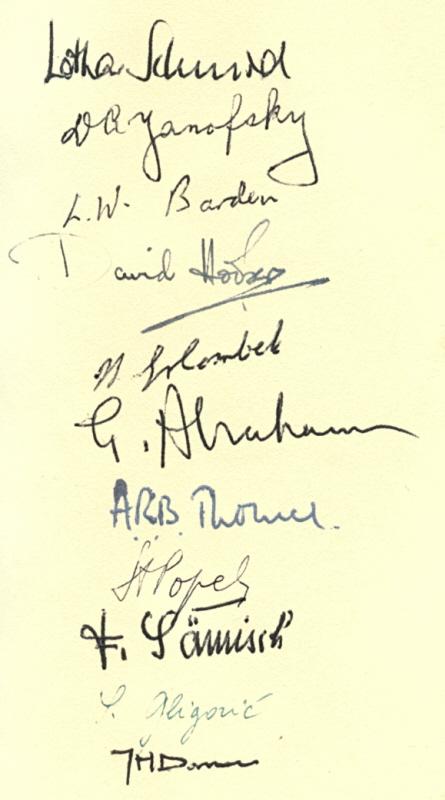
In order: L. Schmid, D. Yanofsky, L. Barden, D. Hooper, H. Golombek, G. Abrahams, A.R.B. Thomas, S. Popel, F. Sämisch, S. Gligorić and J.H. Donner.
Wanted: early attempts to rank leading masters. One was made by Edward Lasker on page xii of his book Chess and Checkers, the Way to Mastership (New York, 1918). He proposed: 1st Em. Lasker; 2nd Capablanca; 3rd Rubinstein; 4th Schlechter; 5th Marshall; 6th Teichmann; 7th Alekhine.
(1976)
Colin Crouch (Harrow Weald, England) points out that on page 50 of The World’s Great Chess Games Reuben Fine said that Emanuel Lasker wrote a book on unemployment. Mr Crouch has been unable to find such a work in any bibliography, although there is a 1911 book, published by Macmillan, London, entitled Unemployment: a social study, by B.S. Rowntree and B. Lasker. Bruno Lasker subsequently wrote extensively about East Asian economies, but it is not known whether he was related to Emanuel. We add that Emanuel Lasker did write about, inter alia, unemployment in The Community of the Future (New York, 1940).
Emanuel Lasker’s brother Berthold (1860-1928) was a strong chessplayer and problemist, and the two were apparently distant relatives of Edward Lasker. C.N. 10 quoted the latter’s claim to this effect, which appeared on page 119 of issue 3 of Lasker & His Contemporaries, published in 1980. On page 184 of the March 1974 Chess Life & Review Edward Lasker wrote: ‘I did not discover that we were actually related until he [Emanuel Lasker] told me shortly before his death that someone had shown him a Lasker family tree on one of whose branches I was dangling’.
Another Lasker was Alfons. Page 143 of the May 1910 Deutsche Schachzeitung gave this game between him and Eduard (i.e. Edward):
A. Lasker – E. Lasker (simultaneous)
Breslau, October 1909
Giuoco Piano
1 e4 e5 2 Nf3 Nc6 3 Bc4 Nf6 4 d3 Bc5 5 Bg5 d6 6 h3 Be6 7 Bb5 a6 8 Bxc6+ bxc6 9 d4 exd4 10 Nxd4 Bxd4 11 Qxd4 c5 12 Qc3 Nxe4 13 Qxg7 Qxg5 14 Qxh8+ Kd7 15 Qxa8 Qc1+ 16 Ke2 Qxc2+ 17 Ke3 Qxf2+ 18 Kd3 c4+ and mate next move.
According to page 48 of Fred Reinfeld’s Chess: win in 20 moves or less, a reprint of his 1948 book Relax with Chess, the two players were brothers. Giving this game on page 15 of 500 Italian Miniatures, Bill Wall affirmed that Black was Emanuel Lasker.
A fifth Lasker (forename unknown) had a game-score published on page 53 of the February 1870 Deutsche Schachzeitung. It was one of three blindfold games played simultaneously by Alexander Alexander in Hamburg on 18 August 1869.
(2106)
A footnote on page 233 of Kings, Commoners and Knaves:
A sixth Lasker, Hermann, a cousin of Edward, was mentioned on page 204 of Deutsches Wochenschach, 13 June 1909.
Avital Pilpel (Haifa, Israel) writes:
‘I have been authorized by Michal Golan to share this photograph which is in her possession. In the inscription her aunt Renate is thanked, for an 85th-birthday present, by Edward Lasker, who was the brother of Michal Golan’s grandfather, Alfons Lasker.’
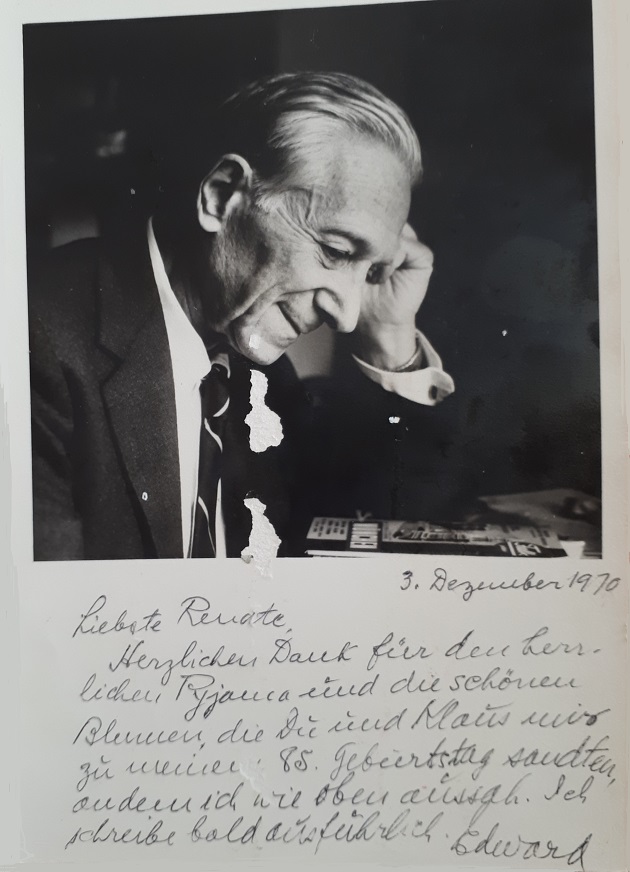
The game given in C.N. 2196 above:
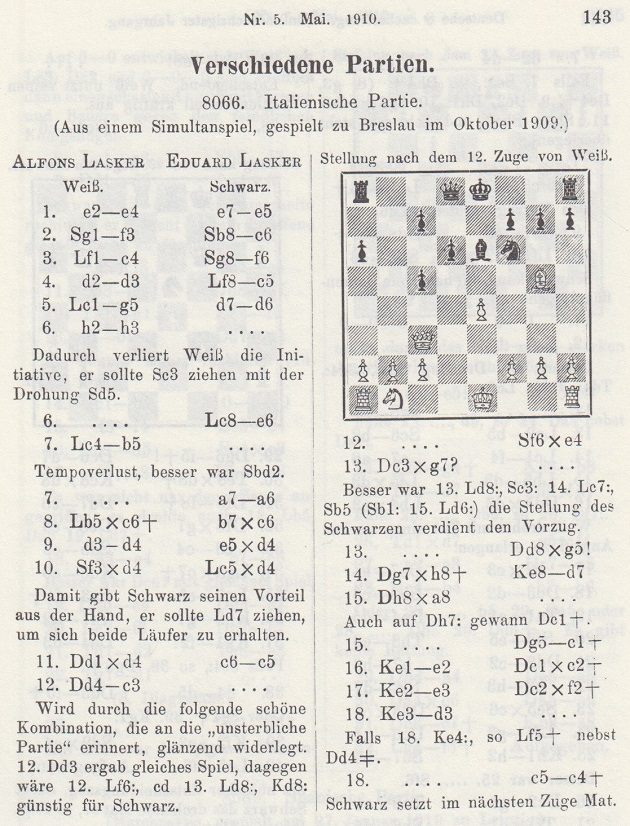
(11646)
On pages 210-211 of The Adventure of Chess (New York, 1950) Edward Lasker relates how, in London in 1912, Gunsberg played a trick on him when getting him to play a game against a woman visitor to the Divan. Only after Lasker had lost did Gunsberg tell him that she was Mrs Fagan, who ‘just recently returned from San Remo, where she won the ladies’ world championship’. The story is also related on page 171 of Bradley Ewart’s Chess: Man vs Machine.
A few contemporary sources, such as page 37 of the second volume of Schachjahrbuch für 1911, refer to a ladies’ tournament in San Remo in 1911, but none mentions the title ‘world championship’ or gives Mrs Fagan as a competitor. They all say that the event was won by Miss Kate Finn of London.
Did Lasker mix up the names Finn and Fagan? And what was the basis for the ‘world championship’ claim?
(2120)
From our feature article on the famous alleged game Adams v Torre:
We own a two-page letter which E.Z. Adams wrote to Hermann Helms, the editor of the Bulletin, on 22 November 1920 (page 1, page 2). We have no information on a draw against ‘Mr E. Laker of Chicago’ in 1920, but page 203 of the December 1921 American Chess Bulletin gave a loss by the Mexican (‘played between Carlos Torres [sic], 16 years old, and Edward Lasker of Chicago during the latter’s visit to New Orleans during November’).
C.N. 2781 gave that game:
Carlos Torre – Edward Lasker
New Orleans, November 1921
Ruy López1 e4 e5 2 Nf3 Nc6 3 Bb5 a6 4 Ba4 Nf6 5 O-O d6 6 d4 b5 7 dxe5 dxe5 8 Qxd8+ Nxd8 9 Bb3 Bd6 10 Re1 c5 11 c4 Be6 12 Rd1 Ke7 13 Nc3 Rb8 14 Be3 Nc6 15 Nd5+ Bxd5 16 cxd5 Nd4 17 Bxd4 cxd4 18 Rac1 Rhc8 19 Bc2 Rc7 20 Bd3 Rbc8 21 Rxc7+ Rxc7 22 a4 bxa4 23 Ra1 a3 24 bxa3 Rc3 25 Bxa6 Nxe4 26 a4 f6 27 Bb5 d3 28 a5 Bc5 29 a6 Bxf2+ 30 Kf1 Ba7 31 Rd1 Nc5 32 Ke1
32…Rc2 33 Bxd3 Nxd3+ 34 Rxd3 e4 35 Rb3 exf3 36 Rb7+ Kd6 37 Rxa7 fxg2 38 Rxg7 Ra2 39 h4 Kxd5 40 a7 Ke4 41 Rg8 Kf3 42 White resigns.
For F.J. Marshall’s book Chess Masterpieces (New York, 1928), the world’s leading masters (and a few others) nominated their best game. On page 48 Edward Lasker put forward his win as Black over Torre, Chicago, 1926.
See The Best Chess Games.
Confusion between Emanuel and Edward Lasker persists. On page 104 of The Amazing Book of Chess (Bramley Books, 1999) Gareth Williams gave the conclusion of the well-known game against Englund at Scheveningen, 1913 in the belief that the then world champion had been White.
An older example comes from page 59 of Famous Chess Players by Peter Morris Lerner (Minneapolis, 1973):
‘In 1921 Sammy [Reshevsky] played in a New York tournament during which former World Champion Emanuel Lasker required 70 moves to beat him.’
Again it was Edward Lasker. He won the tournament, for which 1922 would be the correct date.
(2361)
When C.N. 2361 was given on page 310 of A Chess Omnibus we added a footnote:
In his subsequent book Master Pieces (see pages 127 and 160) G. Williams proved unable even to spell Lasker’s forename, which came out as ‘Emmanual’.
See too the episode related in our feature article on Yates, which included the following, published by the BCM in 2017:
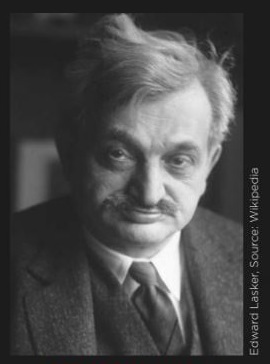
From Javier Asturiano Molina (Murcia, Spain):
‘What information is available about the mysterious game Edward Lasker v Capablanca, Berlin, 1911? The final moves of this “unknown” game (a draw, but Capablanca could have won) were given by Edward Lasker in his book Chess Secrets I Learned from the Masters (page 131) and were also discussed in the 8/1995 New In Chess (page 82). It is absent from the various collections of Capablanca’s games, but has the complete score ever been published?’
The position given in Lasker’s book is as follows:
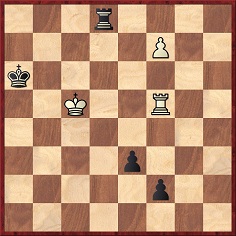
Now Lasker (White) continued 1 f8(Q) Rxf8 2 Rxf8 e2 (2…Kb7!) 3 Kc6 Ka7 4 Rf7+ Ka6 5 Rf8 Ka5 6 Kc5 Ka4 7 Rc4+ Kb3 8 Rf3+ Kc2 9 Rxf2 Drawn.
Had this drawing motif already occurred before 1911?
Lasker wrote in his book that Capablanca ‘thrilled me by his very gracious consent to play an individual game with me’, but did not indicate the rate of play. We have found nothing about their meeting in such contemporary magazines as the Deutsche Schachzeitung and Deutsches Wochenschach.
(2748)
See also Incomplete Games of Chess.
For another game against the Cuban, see Capablanca in London, 1913, which begins:
In C.N. 2617 Ulrich Dirr (Munich, Germany) asked for information about a game between Capablanca and Edward Lasker which finished as follows:
Black played 40…Ke5 and resigned after 41 h6.
J.R. Capablanca (Wiener Schachzeitung, February-May 1914, page 22)
Ed. Lasker (BCM, May 1914, opposite page 169)
Some time ago we were struck by the similarity between the signatures of Emanuel and Edward Lasker in our inscribed copies of The Community of the Future (1940) and The Game of Chess (1972):
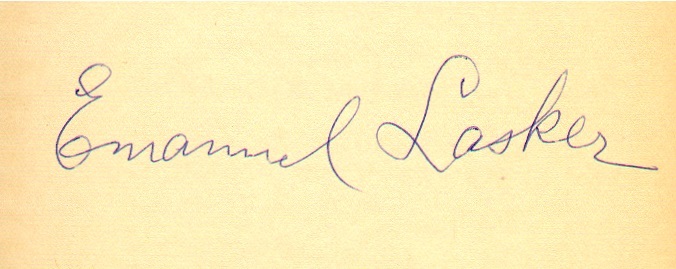
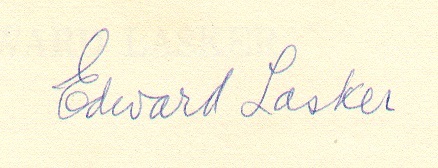
Now we see that Edward Lasker made the same point on page 131 of Chess Life, May 1961:
‘Looking at the signatures of the players with whom I was honored to compete in 1924 [i.e. in the New York tournament] I was astonished to note for the first time the extraordinary similarity between Emanuel Lasker’s signature and my own, and – also for the first time – the perhaps not altogether silly question occurred to me whether, lacking other evidence, this might have served as an acceptable argument for his often expressed opinion that our families were probably related, although we never could find out how. It was not until a few weeks before his death that he told me he had seen a definite proof. A young man from Australia had visited him and shown him a Lasker “family tree”, and there I was, dangling from one of the branches.’
As recorded in C.N. 2106 [see above], Edward Lasker used the same arboreal metaphor on page 184 of Chess Life & Review, March 1974.
(2997)
The full text of C.N. 10 (mentioned above and also given on page 173 of Chess Explorations):
Was Edward Lasker related to Emanuel Lasker? The answer is yes, according to Lasker & His Contemporaries No. 3, which quotes (page 119) a letter from Edward L. dated 8 February 1973 to the magazine’s editor, Robert B. Long:
‘The genealogy, incidentally, indicates that the common forbear of Emanuel and myself was the son Samuel Lasker of the Rabbi of the Polish village Lask, whose name was originally Meier Hindels. However, later the additional name Lasker was given to him to distinguish him from another Meier Hindels also living in Lask. Samuel Lasker moved to another Polish village, Kepno, in 1769, after it had been captured by Frederick the Great and became a German township, and I am the last descendant of his who was born there. He was the greatgrandfather of my greatgrandfather. His first-born son left Kepmen [sic – Kempen] and moved to Jarotschin, another Polish village, and Emanuel Lasker was that one’s greatgrandson.’
Part of a letter from Edward Lasker which was published on page 132 of CHESS, April 1953:
‘This gentleman [Kenneth Harkness] once told me himself that he is in chess only for what money he can make out of it. That is why he was always fighting to increase the speed of tournament play – to some such absurd thing as 50 moves per hour, if I remember correctly – because he felt that more “action” would attract more onlookers, and onlookers was what chess needed in his opinion to make chess pay.
Amateur chess in which the time limit is of minor importance was not different in Mr Harkness’s opinion from master chess in this respect. I hardly need add anything to characterize the fitness of this gentleman to give an opinion on any matters connected with master chess.’
(3065)
On page 168 of the June 1953 CHESS, Lasker wrote that he had not intended his letter to be for publication, did not wish to enter into polemics and therefore retracted his critical remarks.
(3068)
Below, from page 89 of the July-August 1926 American Chess Bulletin, is a shot taken at Lake Hopatcong, 1926 featuring, from left to right, Edward Lasker, José Raúl Capablanca (with his daughter Gloria), Norbert Lederer and Edith Herschenstein:
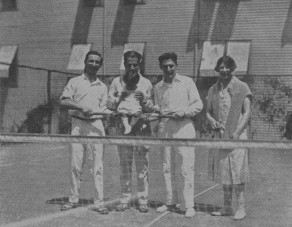
(3716)
From pages 151-152 of Kings, Commoners and Knaves:
On page 260 of the April 1974 Chess Life & Review Edward Lasker made the peculiar claim that it was only during the New York, 1924 tournament that Emanuel Lasker learned of the Marshall Gambit:
‘I had told him [Emanuel Lasker] on one of our morning walks in Central Park that during the war, when of course no chess news crossed the Atlantic, Marshall had invented a pawn sacrifice against the Ruy López which he had tried against Capablanca in a tournament in New York in 1918, but despite his tremendous attack, Capablanca succeeded in refuting it over the board. I told him how this “Marshall attack” went …’
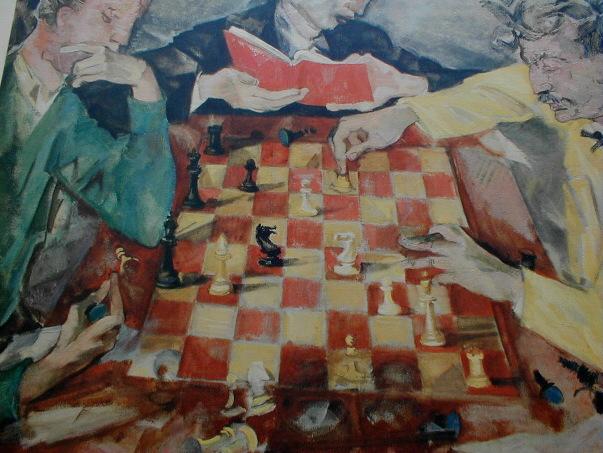
Mark N. Taylor (Mt Berry, GA, USA) sends the above picture and observes:
‘This is Maximilian Mopp’s “Chess with Emanuel Lasker”, of which I have a print (“Copyright 1953. Arthur Rothmann Fine Arts, Inc., N. Y. C.” ). Can anyone identify the position on the board, Lasker’s opponent, or the third figure? Mopp is perhaps best known to chessplayers as the illustrator of Edward Lasker’s Chess for Fun & Chess for Blood.’
(4091)
Jack O’Keefe (Ann Arbor, MI, USA) sends us a copy of the dust-jacket of the first edition of Chess for Fun & Chess for Blood by Edward Lasker (Philadelphia, 1942):
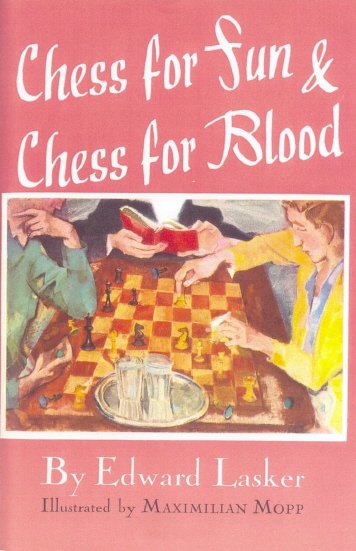
(4348)
See Chess and Paintings.
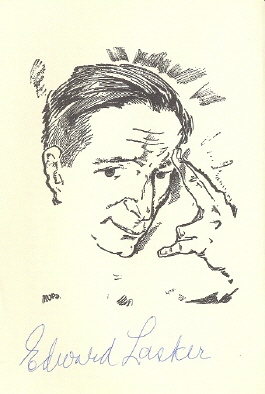
From pages 66-67 of Chess for Fun & Chess for Blood by Edward Lasker (Philadelphia, 1942):
‘[The diagram below] shows a position which I had in the first chess tournament I ever played, at the age of 18. I shall never forget it because had I made the right move I would have won the Berlin championship. I had prematurely resigned myself to losing this game because my king is held on the queen’s wing by my opponent’s passed pawn, so that he can leisurely attack my pawns with his king and queen one of his pawns on the king’s wing.
In that frame of mind I played half mechanically 1 f4 and resigned the game when Black replied ...f6, as the three black pawns hold my four pawns. If I advance my knight’s pawn Black simply walks over to the king’s wing.
Had I carefully analyzed the consequences of 1 f6!! I would have probably seen that this move wins the game. After 1...gxf6 2 f4 the threat is 3 g5, freeing the rook’s pawn, so that Black must play 2...Kd4 3 g5 fxg5 4 fxg5 Ke5 5 gxh6 Kf6. But now comes the surprise: 6 Kc2 forces Black’s king to move, and his only pawn prevents him from reaching my pawns. No matter where he moves, 7 h7 wins.’
Lasker also wrote about the position in Chess Strategy (e.g. on pages 84-85 of the London, 1915 edition), where Black was named as Moll and the occasion was given as ‘Berlin championship, 1904’. On the other hand, circa 1907 could be inferred as the date from what Lasker, who was born in December 1885, wrote on page 105 of the April 1963 Chess Review. Ossip Bernstein’s name was introduced into the account:
‘I met Bernstein in Berlin over 56 years ago when both he and I were young students. I was competing in a tournament and I had just resigned my game against the opponent leading the contest. [Here Lasker gave the above diagram and the moves 1 f4 f6.]
Then an onlooker behind my chair said to me with a smile, “Do you know that, just a move before you resigned, your opponent could have done so?” I turned to the man in surprise and was struck by his extraordinarily good looks. He was about six foot three, slim as a young tree, and very handsome with black hair, a high forehead and large shining eyes. I asked him who he was; and, when he introduced himself as Ossip Bernstein, I was overawed.
He showed me that with 1 f6! my game was won. [Lasker added the same analytical line as above.] I thanked Bernstein for this lesson, and we went out to dine together. It did not take us long to discover that we were both lovers of music, and this forged a strong bond of friendship.’
In Lasker’s similar, though brief, account of his meeting with Bernstein on page 75 of Chess Secrets I Learned from the Masters (New York, 1951) the chronology suggested that it occurred no earlier than the end of 1909 (after Lasker’s match against Erich Cohn).
So when was the game played? The answer is 1907. Below is the full score, from which it will also be seen that the endgame position given by Lasker in his books and article was incorrect. The game was published on pages 65-66 of Deutsches Wochenschach, 24 February 1907, with the heading ‘Winterturnier (1. Kl.) der Berliner Schachgesellschaft, Jan. 1907 (7 Rde)’:
Eduard [later Edward] Lasker – Kurt Moll
Berlin, January 1907
Queen’s Gambit Declined
1 d4 d5 2 c4 e6 3 Nc3 c5 4 cxd5 exd5 5 Nf3 Nc6 6 Bf4 Nf6 7 e3 Be6 8 Qb3 Nb4 9 Bb5+ Bd7 10 O-O c4 11 Qa4 a6 12 Bxd7+ Qxd7 13 Ne5 Qxa4 14 Nxa4 Nh5 15 a3 Nxf4 16 exf4 Nc6 17 Rfe1 Be7 18 Nxc4 dxc4 19 d5 b5 20 Nc3 O-O-O 21 dxc6 Bf6 22 Rad1 Rxd1 23 Rxd1 Bxc3 24 bxc3 Rd8 25 Rxd8+ Kxd8
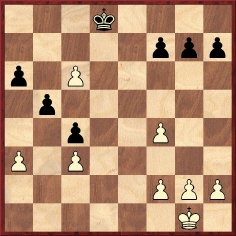
26 Kf1 Kc7 27 Ke2 Kxc6 28 g4 a5 29 h4 Kc5 30 f5 b4 31 cxb4+ axb4 32 axb4+ Kxb4 33 Kd2 Kb3 34 Kc1 Kc3 35 h5 h6
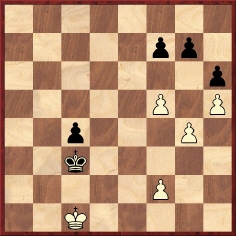
36 f4 f6 37 White resigns.
Thus Lasker’s writings inverted the position of Black’s king and pawn on c3 and c4.
The crosstable of the 15-player event was published on page 146 of the 28 April 1907 issue of Deutsches Wochenschach. Given that Lasker finished equal eighth and ninth, six points behind the winner Treybal (whereas Moll was fourth), it is unclear why he wrote regarding his game against Moll (played, as noted above, as early as round seven), ‘had I made the right move I would have won the Berlin championship’.
Kurt Moll, who was also a chess composer, died on 14 November 1915 in Russia, on the Eastern Front, as reported on pages 333 and 345 of Deutsches Wochenschach, 5 December 1915:
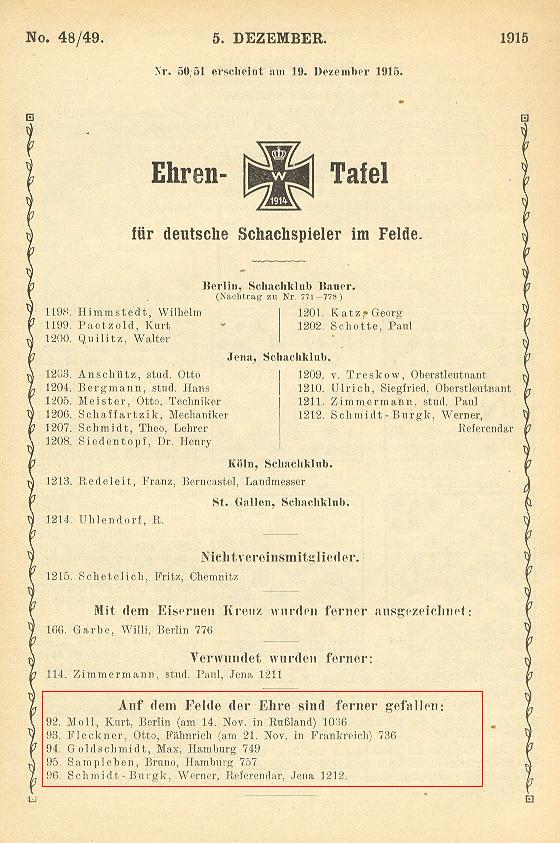
(4239)
In the above item Lasker’s use of the descriptive notation was converted to the algebraic. It is, though, worth recalling that, as mentioned on page 154 of A Chess Omnibus, Lasker used the algebraic notation, controversially, in Chess and Checkers The Way to Mastership (New York, 1918).
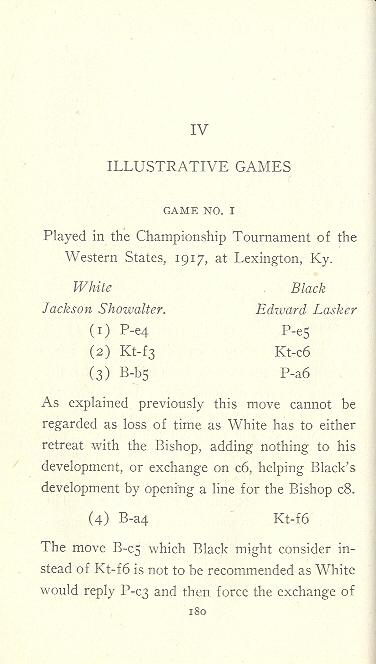
(4240)
Chess in 1924 pointed out that F.P. Betts of London, Ontario had a letter published on page 204 of the November 1924 American Chess Bulletin in which he denounced a book by Edward Lasker (unnamed, but presumably Chess and Checkers The Way to Mastership) for using the ‘extraordinary’ algebraic notation. ‘This mania for improving the established chess notation by freak innovations seems to entirely overlook the fact that there is an immense volume of chess literature centuries old in which the old and accepted notation is enshrined, the value of which would be greatly impaired if this novel jargon should become the vogue.’
Information is still being sought about the lesser-known chess writings of Alfred Kreymborg. The latest specimen we have found is his complimentary review of Edward Lasker’s The Adventure of Chess (New York, 1950) on page 19 of the New York Times, 17 December 1950.
(4645)
Below are inscriptions (by Morley and by Edward Lasker) in two of our copies of the New York, 1946 edition of My one Contribution to Chess by F.V. Morley:
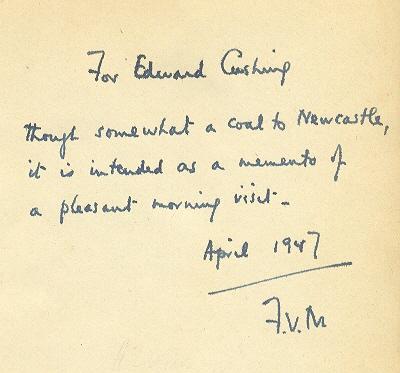
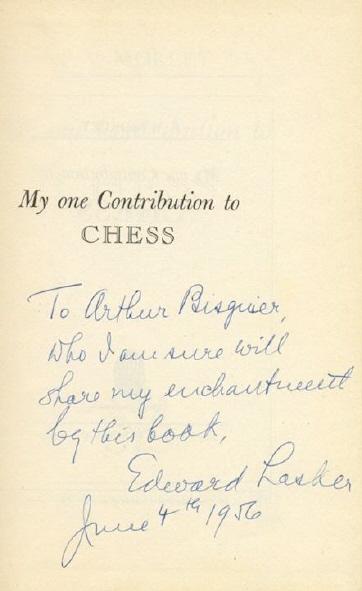
Although chess sources offer virtually no factual information about him, we note an academic webpage which reports that ‘Frank Vigor Morley (1899-1985) became a director of the publishing firm Faber and Faber but was also a mathematician who collaborated with his father for over 20 years’. Regarding Frank Morley senior (1860-1937) the same source affirms:
‘We mentioned that Morley was a chess enthusiast while at school and, indeed, he was an exceptionally good chess player ... He played at the highest level and beat Lasker on one occasion while Lasker was world chess champion.’
(4651)
Concerning the feature article on Edward Lasker v George Thomas we now note that Lasker also published the game on pages 216-217 of the second edition of his book Schachstrategie (Leipzig, 1914). Remarkably, this yields a ninth version of the first nine moves: 1 d4 f5 2 Nf3 e6 3 Nc3 Nf6 4 Bg5 Be7 5 Bxf6 Bxf6 6 e4 fxe4 7 Nxe4 b6 8 Ne5 O-O 9 Bd3 Bb7. In the table of contents (page viii) the game was mysteriously dated 1904.
The game-score was not included in Lasker’s Chess Strategy (London, 1915), which was based on that second German edition.
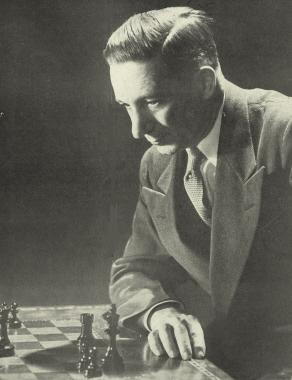
Edward Lasker (front cover, Chess Review, June 1950)
Lasker described the success of the book in an article on page 7 of the March-April 1943 issue of the Chess Correspondent:
‘I believe my book Chess Strategy, the sale of which (between 40,000 and 50,000 copies) exceeded that of any other chess book, achieved its success solely because for the first time it offered the student a real theory of the game which they could apply to any position, according to their more or less thorough grasp of the general strategic principles explained in the book.
I remember that in reviewing that book the great Schlechter, with whom Emanuel Lasker had just barely drawn his match for the world championship, called the teaching method I employed so superior to any used previously that he hoped it would be adopted by all future chess authors. This honor of imitation has indeed been conferred upon me by most authors who later wrote again on chess strategy or tactics, including Capablanca and Nimzowitsch, the former doing it in a more superficial, the latter in a more profound, manner. At any rate, books which offered a theory consisting of opening collections became a matter of past history.
The fundamental innovation I introduced was to teach judging a position by the permanent or transitory form of the pawn skeleton, the mobility which could be given to the various pieces, and weighing of weak and strong points in forming all decisions.’
(5172)
A group photograph from page 127 of the September-October 1928 American Chess Bulletin:
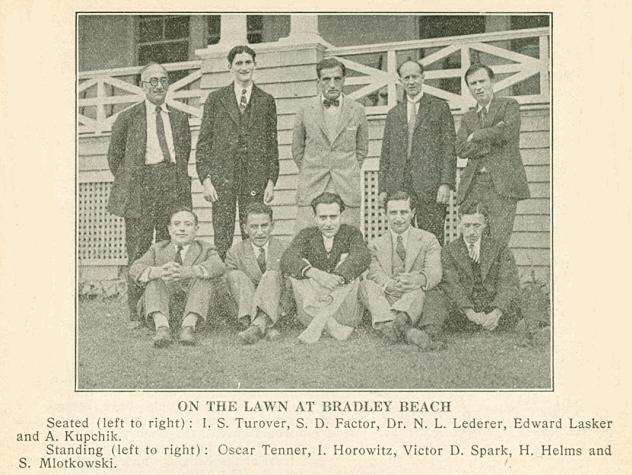
(5179)
From page 190 of Modern Chess Strategy by Edward Lasker (London, 1951):
‘I recall a remark which Emanuel Lasker made one day as we were discussing the characteristic differences between the older and the younger generation of chess masters. He said modern tournaments were much harder because the young masters played much more exact chess than was encountered in tournaments up to the great meeting in New York in 1924. He felt that the old masters – Steinitz, Schlechter, Tarrasch, Teichmann, Bernstein, etc. – had played just as deep chess as can be found in any modern game, perhaps even deeper because they played more slowly, but that they lacked the accuracy with which present-day masters took advantage of the slightest positional superiority.’
(5189)
Wanted: specimens of the anti-Turton theme in over-the-board play. Only two instances have been given in C.N. so far (see C.N.s 553 and 681, on pages 5-6 of Chess Explorations).
The first occurred in the game Edward Lasker v Marshall, New York, 1924.
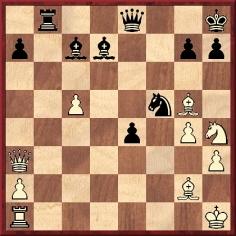
White played 28 Bf4 (preventing ...Qe5).
Wolfgang Heidenfeld’s explanation of the anti-Turton theme, using the above example, was quoted in C.N. 553 from pages 10-11 of his book Lacking the Master Touch (Cape Town, 1970):
‘It consists in forcing the attacker who wishes to double two pieces on the same gait in such a way as to have the stronger piece in front and the weaker behind (called the Turton in the jargon of problemists) into playing the weaker piece across the so-called “critical square” (here Black’s K4) and thus into reversing the planned line-up ...’
See The Anti-Turton Theme in Chess.
From Chess and Music:
Regarding Mischa Elman, Moriz Rosenthal and other musicians, see pages 222-224 of Chess Secrets I Learned from the Masters by Edward Lasker (New York, 1951).
Our 1989 book on Capablanca quoted Edward Lasker on pages 427-428 of Chess Secrets I Learned from the Masters (New York, 1951) and on page 263 of the April 1974 Chess Life & Review. He indicated that in later years Capablanca came to prefer a 10x8 board, but we recall no writings to that effect by the Cuban or, indeed, anything published by him on ‘changing the rules’ after the 1920s. [See, however, C.N. 11861 below.]
There is an excellent entry for Capablanca Chess on pages 38-40 of The Encyclopedia of Chess Variants by David Pritchard (Godalming, 1994).
(5618)
On the subject of Capablanca’s proposals for different forms of chess, Richard Forster (Winterthur, Switzerland) has found the following on page 3 of the Moscow Daily News, 23 April 1935 (‘Translated from Komsomolskaya Pravda’):

(11861)
See Chess Variants and Rule Changes.
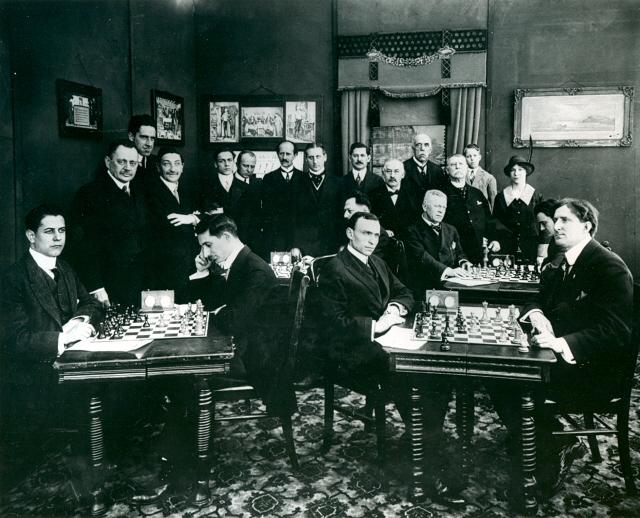
In this photograph J.R. Capablanca, Edward Lasker, J. Bernstein and F.J. Marshall are readily identifiable in the foreground, but few of the remaining figures are easy to name. Can readers assist us in preparing a complete key?
(5742)
See New York, 1915: A Chess Photograph.
‘It made me very sad to learn, some time during the last war, that Yates had committed suicide, apparently for financial reasons. He had probably been too modest to ask British chessplayers for help.’
That comes from page 338 of Chess Secrets I Learned from the Masters by Edward Lasker (New York, 1951), a book which has helped spread a number of myths. Even at first glance, the passage above fails to impress, with its ‘apparently’ and ‘probably’ and, above all, its curious reference to ‘during the last war’ (given that Yates died in 1932).
Olimpiu G. Urcan (Singapore) notes that additions continue to be made to the Library of Congress photograph collection, including a good shot of Tartakower and Edward Lasker.
(5864)
From pages 20-21 of Chess Secrets I Learned from the Masters by Edward Lasker (New York, 1951), in the section on Curt von Bardeleben:
‘He always wore a black cut-away suit of dubious vintage. Apparently he could never spare enough money to buy a new suit, although I learned one day that at fairly regular intervals he received comparatively large sums – from one to several thousand marks – through the simple expedient of marrying, and shortly after divorcing, some lady who craved the distinction of his noble name and was willing to pay for it. Unfortunately, when he received his reward, it was usually far exceeded by the amount of the debts he had accumulated since his last divorce. Evil tongues had it that the number of the ladies involved in these brief marital interludes had grown so alarmingly that they could easily have made up a Sultan’s harem.’
Can any independent corroboration of these claims be found?
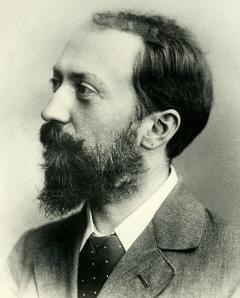
Curt von Bardeleben
(5999)
Richard Forster (Zurich) writes:
‘I have checked the civil records available at Ancestry.com (Berlin, Germany, Marriages, 1874-1920. Provo, UT, USA: Ancestry.com Operations, Inc., 2014), the original data being from the Landesarchiv, Berlin.
These records confirm, at least partly, Edward Lasker’s story, as they show that Curt von Bardeleben married ten times between 1902 and 1919:
- 13 September 1902-19 December 1903: Hedwig Beyer (born 24 June 1870; died 10 June 1959);
- 18 April 1906-20 October 1906: Katharina Kastenmayer (born 8 February 1875);
- 12 February 1907-12 July 1907: Heinriette Elisabeth Boehnke (born 5 September 1857);
- 19 August 1907-13 March 1915: Charlotte Luise Therese Michel (born 3 May 1886);
- 24 April 1915-21 July 1915: Ilse Marie Auguste Sack (born 17 February 1891);
- 25 February 1916-27 June 1916: Martha Helene Goetsch (born 4 November 1869);
- 20 November 1916-21 May 1917: Rosa Ida Hedwig Krüger (born 13 August 1879);
- 14 June 1917-13 June 1918: Marie Elisabeth Thierau (born 8 April 1888);
- 1 August 1918-8 February 1919: Anna Luise Lange (born 6 June 1892);
- 25 February 1919: Auguste Anna Ida Schulz (born 18 December 1877).’
(10592)
The article by Irving Chernev on the inside front cover of the April 1954 Chess Review (C.N. 6077) included 15 alleged quotes, none with sources. One was: ‘That boy understands as much of chess as I do of rope dancing.’ Page 125 mentioned that the speaker was ‘Janowsky, referring to his game with the prodigy Reshevsky’. The complete feature was reproduced on page 271 of Chernev’s The Chess Companion (New York, 1968).
On page 243 of Chess Secrets I Learned from the Masters by Edward Lasker (New York, 1951) it was reported that Janowsky had made the remark to Lasker after 12 moves of the game Janowsky v Reshevsky, New York, 1922. It was a famous victory for the ten-year-old prodigy, and the following appeared on page 18 of Reshevsky on Chess (New York, 1948):
‘I was so excited and happy that I rushed home in a taxi to tell my father and mother. I couldn’t even sit down in the taxi. I jumped up and down all the way. When I got to the hotel, I ran up the stairs to our rooms, without waiting for the elevator, and broke the news to my parents: I had won from Janowsky! And then I sang. I sang so loudly that nobody could talk. It was one of the happiest days of my life.’
In Edward Lasker’s version (pages 247-248 of Chess Secrets) the prodigy’s father was in the taxi. The report on page 28 of the Sports Section of the New York Times, 13 October 1922 stated:
‘After 65 moves had been recorded, Janowsky, seeing his pawns falling one by one, resigned and was the first to offer his congratulations to the boy.’
This photograph was given on page 158 of the November 1922 American Chess Bulletin:
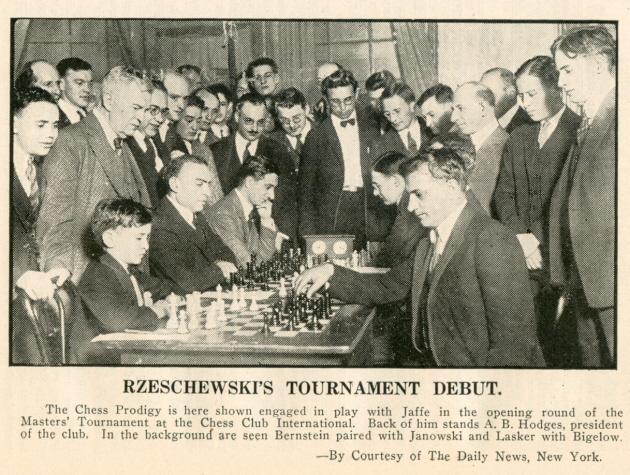
The tournament received a brief mention on pages 193-194 of A History of Chess by H. Golombek (London, 1976). Reshevsky’s final score and his placing were incorrect, as were Bigelow’s. Jacob Bernstein was misidentified as ‘S. Bernstein’, and the index reference to Jaffe gave his forename as Oscar, instead of Charles.
(6083)
Bernd Graefrath (Mülheim an der Ruhr, Germany) quotes a news item on page 253 of the August 1933 Wiener Schachzeitung:
‘Chicago. Einer Zeitungsnachricht zufolge wurde Exweltmeister Lasker in einem Auto von zwei Negern überfallen. Mit Hilfe seines Revolvers konnte er jedoch die Banditen in die Flucht jagen.’
We believe that in the 1930s Emanuel Lasker did not visit the United States until 1937. The reference to Chicago in the above report may suggest a mix-up with Edward Lasker, who lived there for part of his life, but no corroborative evidence has been found so far.
(6410)
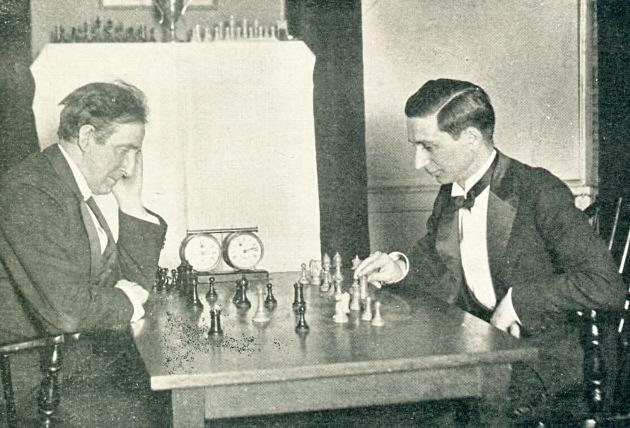
In this photograph, taken from page 8 of the December 1944 Chess Review, Frank J. Marshall and Edward Lasker are engaged in the first game of their 1923 match for the US championship. Lasker is about to play 31 Rc2, the move which was sealed at the first adjournment (American Chess Bulletin, March 1923, pages 51-52). For his notes to parts of the game, see pages 251-256 of his book Chess Secrets I Learned from the Masters (New York, 1951).
(6552)
Addition on 20 December 2022:
Olimpiu G. Urcan has sent us this fine version of the above photograph:
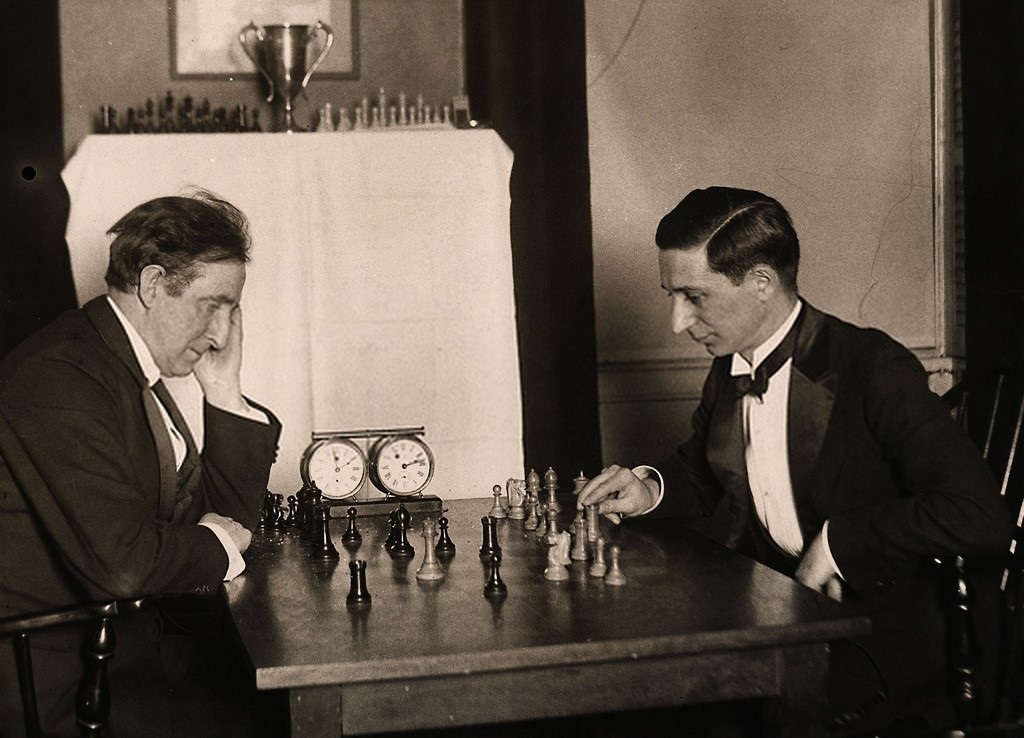
From an annotation on page 156 of the May 1961 Chess Review, in the magazine’s postal section (conducted by Jack Straley Battell):
‘... or, in the more erudite language of Dr Tartakower, “The equalizing injustice of chess”.’
A passage on page 251 of The Chess Masters on Winning Chess by Fred Reinfeld (New York, 1960):
‘... Bernstein made a point of what he called “the equalizing injustice of chess”. By this he meant, presumably, that the apparent unfairness of such a loss is canceled by a sequence of blunders: the player who finally pays for a mistake has probably escaped punishment for earlier mistakes. In the long run, undeserved victories will balance out with undeserved losses. (Of course, the term “undeserved” raises problems, for a mistake deserves to be punished.)’
It is indeed to Bernstein that the phrase is usually ascribed. See, for instance, pages 178-179 of Chess for Fun & Chess for Blood (Philadelphia, 1942) and pages 75 and 94 of Chess Secrets I Learned from the Masters (New York, 1951), to mention two books by Edward Lasker.
Even so, the earliest citation that we can offer at present is from Edward Lasker himself (with no reference to Bernstein), in his annotations to a game on page 301 of the July 1913 BCM:

(6912)
Page 446 of The Game of Chess by Edward Lasker (Garden City, 1972) referred to ‘a remark which the great German master Siegbert Tarrasch made some threescore years ago’:
‘To win a pawn in the opening is usually a dangerous thing.’
What more is known about that observation?
In the algebraic edition, typeset and edited by John Nunn (London, 1997), see page 351.
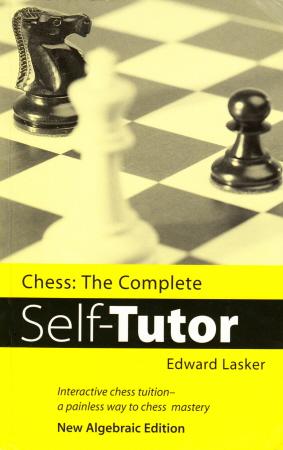
The back cover describes the book as ‘one of the longest established, yet still most innovative, introductory chess manuals’, ‘Lasker’s masterwork’ and ‘the definitive chess teaching manual’. We are, though, struck by the relative lack of publicity accorded to any of the editions published between 1972 and 1997.
Below is the inscription in our copy of the original US volume:
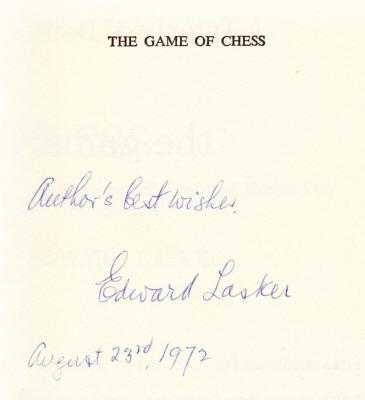
(7762)
Per Skjoldager (Fredericia, Denmark) notes that on page 294 of the October-November 1913 Wiener Schachzeitung Nimzowitsch attributed to Tarrasch the following observation:
‘Die Annahme des Gambits ist prinzipiell verfehlt, weil gefährlich.’
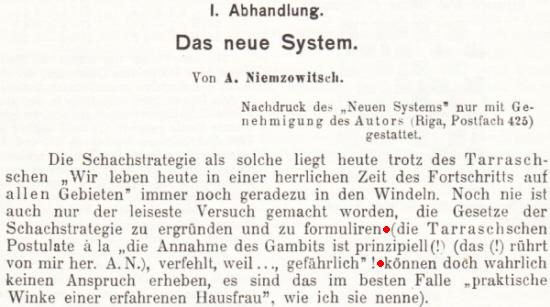
(7770)
A contribution from Olimpiu G. Urcan:
5 feet 9 inches – Source: Passport Application (1921), National Archives and Records Administration (NARA); Washington, DC; Passport Applications, 1795-1905; Collection Number: ARC Identifier 566612/MLR Number A1 508; NARA Series: M1372; Roll #: 247. Via ancestry.com.
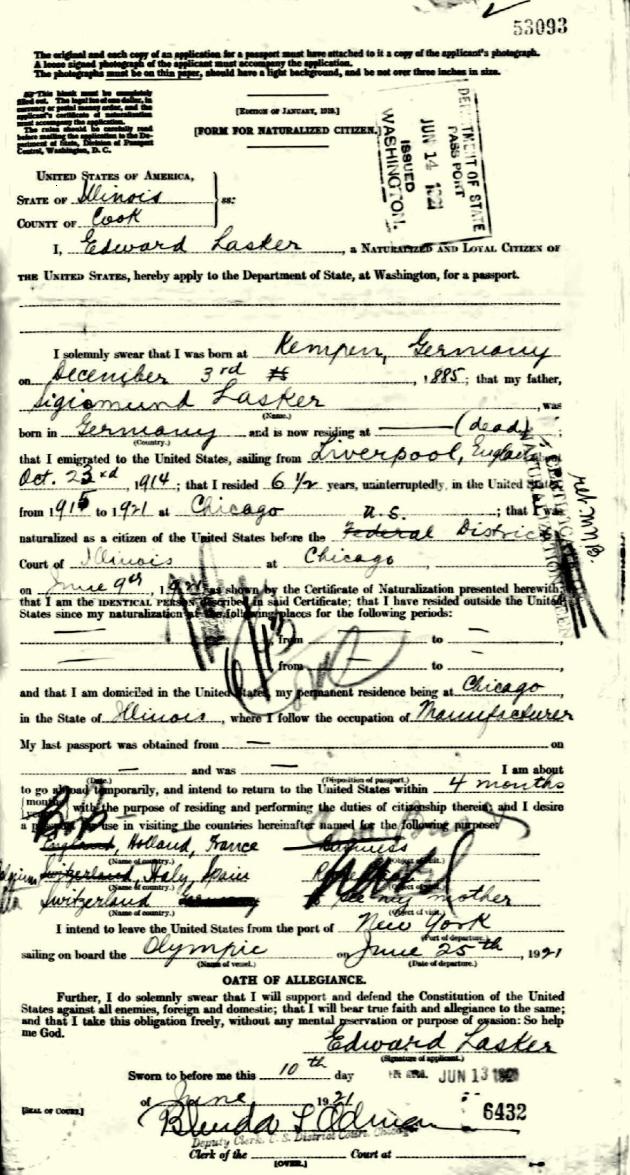
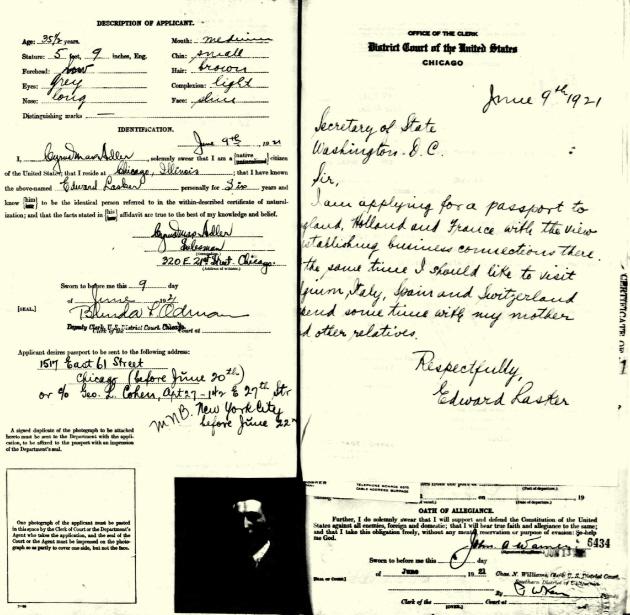
(7885)
From page 10 of the January 1976 Chess Life & Review, in an article on Edward Lasker by Mona M. Karff:
‘Lasker is reticent about the tragedies in his life: his charming and talented wife, to whom he had been happily married for only six months, died after a minor operation as a result of a surgeon’s error; and his mother and brother perished in Nazi Germany.’
The death of his wife, Cecile Mathilde Heller, was reported on page 194 of the December 1920 American Chess Bulletin:
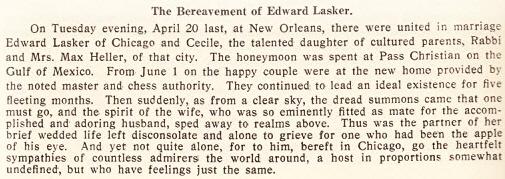
From page 156 of Louisiana’s Art Nouveau by S. Ormond and M.E. Irvine (Gretna, 1976):
‘Heller, Cecile Mathilde (1890-1920). Cecile Heller (Mrs Edward Lasker) was awarded a Diploma in Art in 1911. The year before she had received the Holley Medal for highest excellence in watercolor throughout the session. Her father was Rabbi Max Heller, head of Temple Sinai in New Orleans for 40 years.
She married a US chess champion and went to live in Chicago. She had been married only six months when she died at age 30, leaving a portfolio of watercolor paintings of every room of the mansion in which she lived.
She exhibited a bookplate in the crafts show at Newcomb on 2 April 1911, according to the Times Picayune of that day.’
Edward Lasker’s bookplate was discussed in C.N. 2524 (see pages 181-182 of A Chess Omnibus), and below is one of the specimens in our collection, in the 1920 volume of Deutsches Wochenschach. The artist is named as ‘C.M. Heller’.
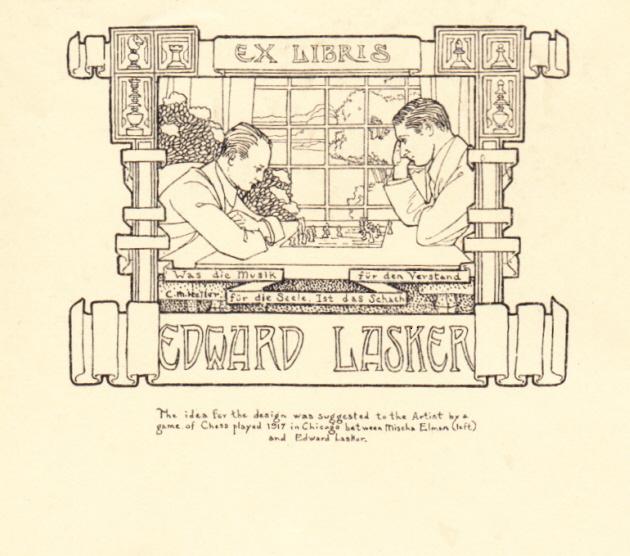
As mentioned in the earlier C.N. item, the photograph on which the illustration is based (Mischa Elman in play against Lasker) was published on page 27 of the February 1918 American Chess Bulletin:
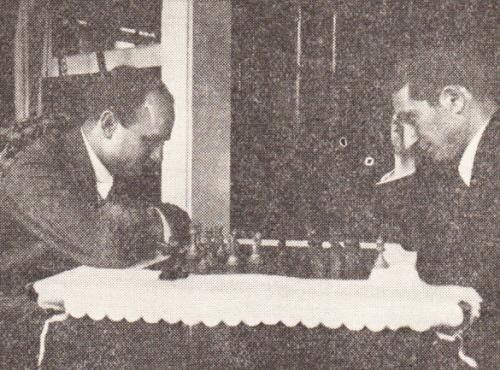
(7886)
The Center for Jewish History has a number of sketches of leading masters by Emery Gondor. They are dated 1922.
A search for ‘Lasker’ also yields some interesting illustrations, including a fine version of the photograph of Edward Lasker and Emanuel Lasker at the board (given in the Dover reprint of the New York, 1924 tournament book, although not in the original edition).
(8457)
‘He was the wittiest man I ever met’, wrote Harry Golombek about Savielly Tartakower on page 65 of Chess Treasury of the Air by Terence Tiller (Harmondsworth, 1966). Some bons mots were given on subsequent pages.
Below is an extract from part one of Edward Lasker’s article ‘The New York Tournament of 1924’, on page 185 of the March 1974 Chess Life & Review:
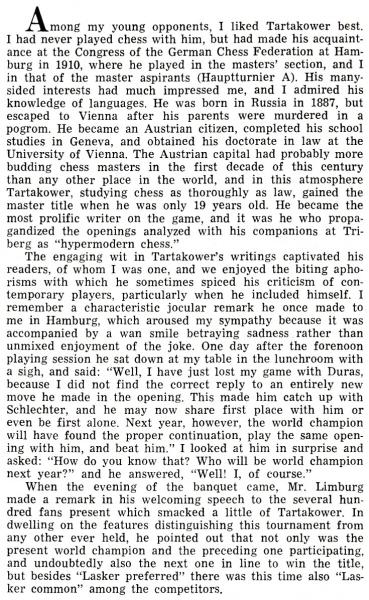
(8699)
Eduardo Ramirez (Chicago, IL, USA) sends a game between Sergei Prokofiev and Edward Lasker which he found in the Chicago Daily News, 9 January 1922:
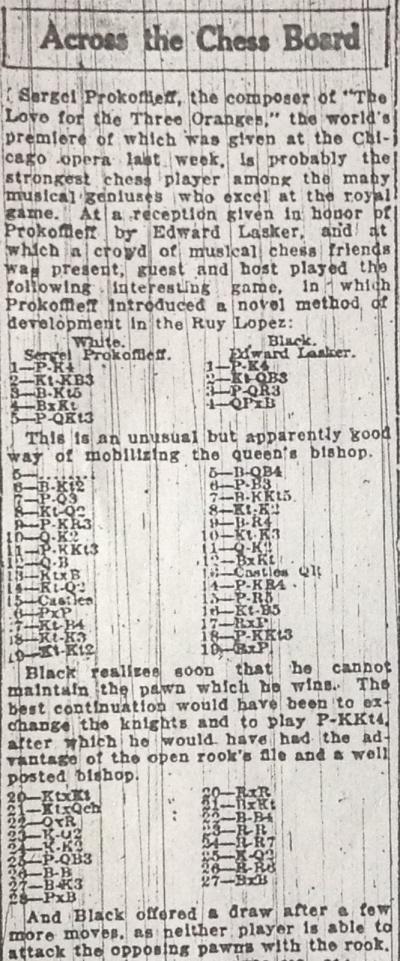
Our correspondent has posted the game on his website (A Chess Reader), noting that the score was garbled by the newspaper. Below is an attempt to repair it:
1 e4 e5 2 Nf3 Nc6 3 Bb5 a6 4 Bxc6 dxc6 5 b3 Bc5 6 Bb2 f6 7 d3 Bg4 8 Nbd2 Ne7 9 h3 Bh5 10 Qe2 Ng6 11 g3 Qe7 12 Qf1 Bxf3 13 Nxf3 O-O-O 14 Nd2 h5 15 O-O-O h4 16 gxh4 Nf4 17 Nc4 Rxh4 18 Ne3 g6
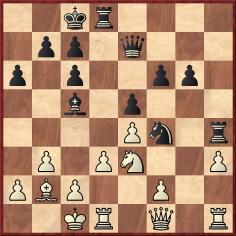
19 Ng2 Rxh3 20 Nxf4 Rxh1 21 Nxg6 Rxf1 22 Nxe7+ Bxe7 23 Rxf1 Bc5 24 Kd2 Rh8 25 Ke2 Rh2 26 c3 Kd7 27 Bc1 Rh3 28 Be3 Bxe3 29 fxe3. The game was agreed drawn a few moves later.
The game was annotated by Lasker on pages 237-242 of Chess Secrets I Learned from the Masters (New York, 1951).
(8809)
Edward Lasker wrote about Prokofiev and their meeting in Chicago on pages 199-201 of The Adventure of Chess (New York, 1950).
(8823)
Wanted: the newspaper article referred to by Edward Lasker on page 159 of Chess for Fun & Chess for Blood (Philadelphia, 1942):
‘As Horace Bigelow, who covered the tournament for one of the New York papers, remarked at the time: “The modern school came, saw and succumbed.”’
From page 92 of Lasker’s The Adventure of Chess (New York, 1950):
‘... the amusing though erroneous comment of a chess columnist was: “The New School came, saw, and succumbed.”’
(8916)
From page 6 of the Brainerd Daily Dispatch, 18 October 1922:
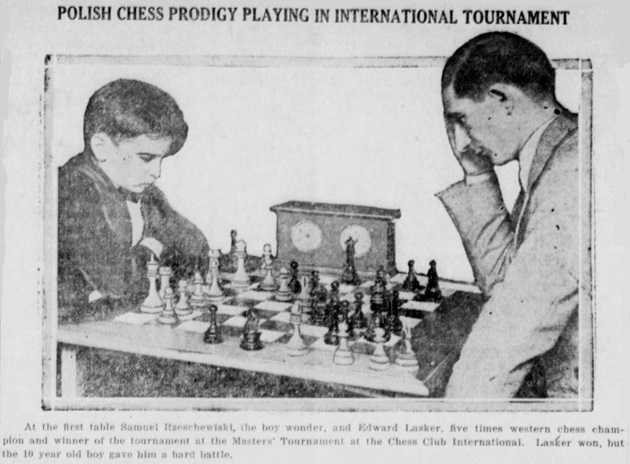
(9204)
Wanted: a better copy of the photograph below, which was published on page 4 of the Chicago Daily Tribune, 18 March 1921:
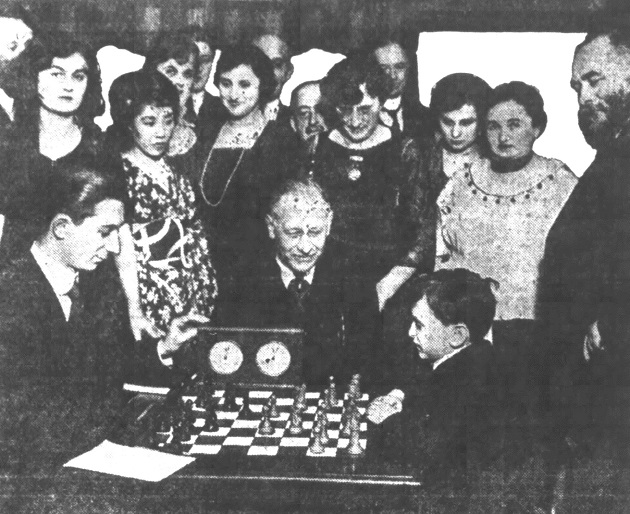
The newspaper’s caption was:
‘The youthful chess wizard, Samuel Rzeschewski, is seen here playing against Edward Lasker, western chess champion, seated opposite. Julius Rosenwald, the referee, is seated between them; Spectators from left to right are Alma Wells, who played the youthful prodigy at the Illinois Athletic club last Saturday night; Mrs Tachibana, cousin to the Emperor of Japan, Sophia Novakobsky, Mrs Julius Rosenwald, Mrs Jacob Rzeschewski, the boy’s mother, and, next to her, his father.’
(9426)
See also our feature article on Reshevsky as a chess prodigy.
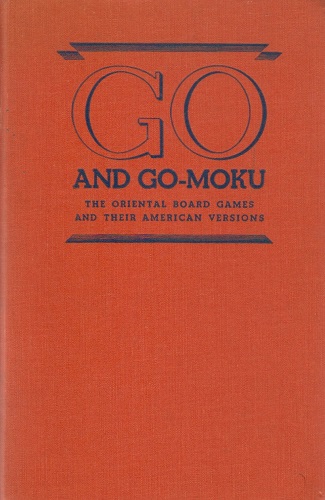
In 1934 Edward Lasker brought out a 214-page book Go and Go-Moku. A revised edition was issued by Dover in 1960, and below is the title page of our signed copy:
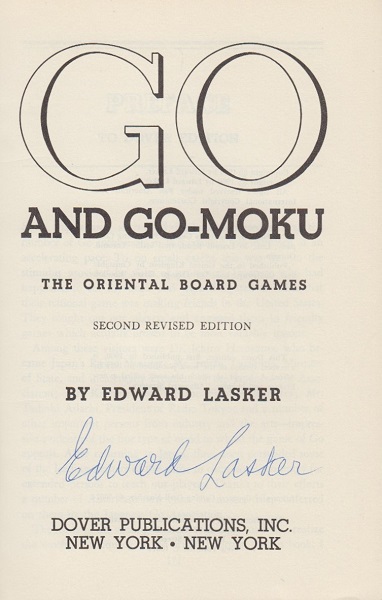
Lasker included a lengthy appendix on Go in the Philadelphia, 1945 edition of Modern Chess Strategy:
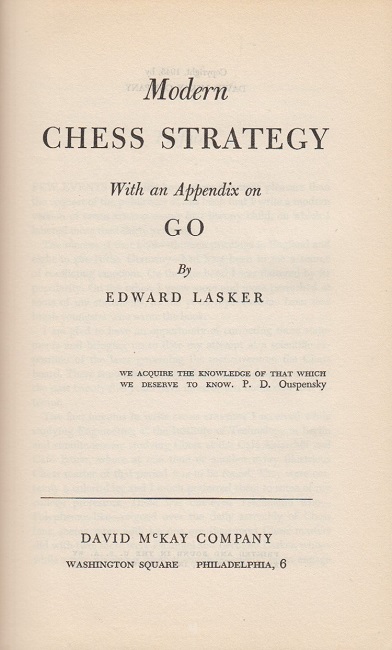
The book had two photographs, between pages 368 and 369:
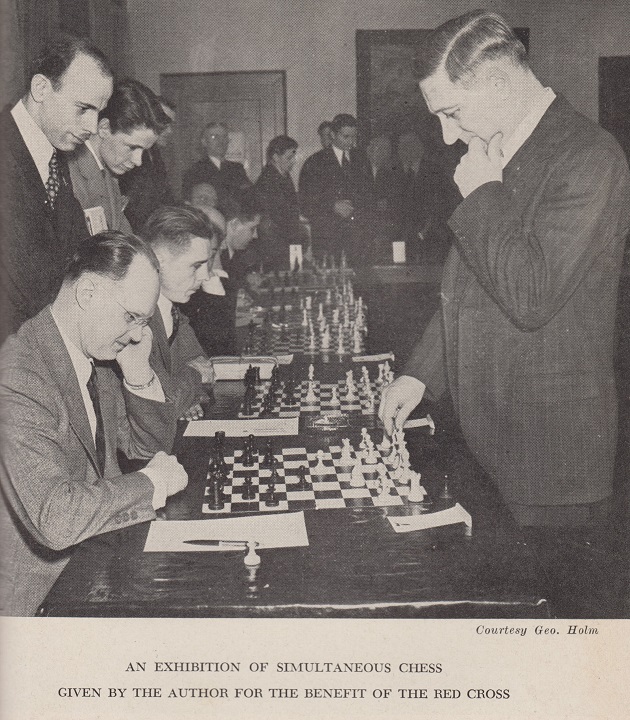
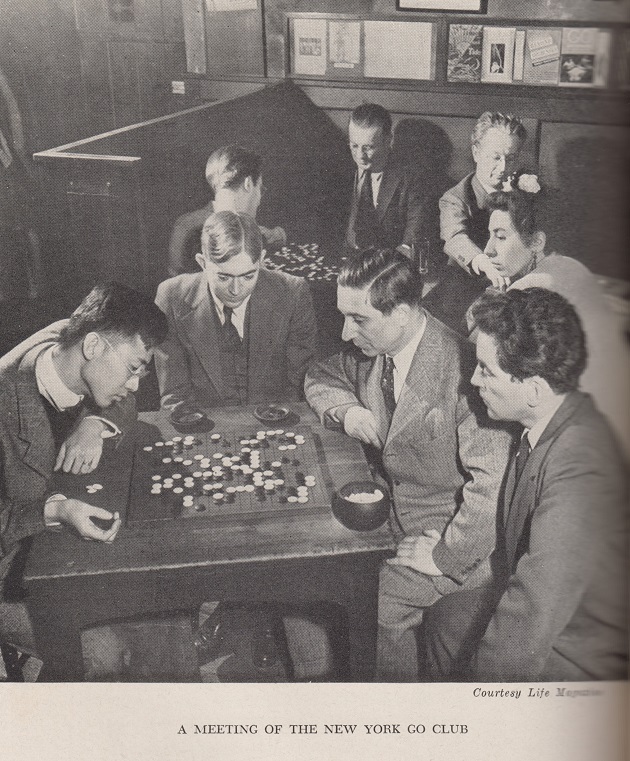
When the 1945 edition of Modern Chess Strategy was reviewed on pages 112-113 of Chess World, 1 June 1946, C.J.S. Purdy praised the chess coverage but criticized the Go material:
‘We cannot understand how so logical a man could have added a 66-page appendix on the game of Go. The McKay Company will be wise to omit Go from the second edition, enabling them to lower the price.
We cannot discuss Go here, except insofar as Lasker compares it with chess. Following false “authorities”, he makes a colossal error in saying it is older than chess, “possibly three times as old”.
After mentioning Chinese legends setting the invention of wei-chi (go is only the modern Japanese name) as far back as 2000-odd BC, he goes on to say, more confidently:
“It is certain that in the tenth century BC, Wei-Chi was well known, for it is mentioned in a number of poems and allegories found in Chinese works dating from that period.”
The game mentioned is some other -chi, not wei. Chi means simply a board game. Lasker is about 20 centuries out.
H.J.R. Murray, the world authority on the histories of indoor games, wrote in a letter to us dated 15 January, “We now know that wei-chi, which the Chinese encyclopaedias date back to 2300 BC, was really only invented about 1000 AD.”
Later, Murray wrote to us:
“I haven’t Edward Lasker’s book, but from what you say I think he has used Korschelt’s articles on Go in the Mittheilungen der deutschen Gesellschaft für Natur- und Völkerkunde Ostasiens 1881, for I find the same story there. My impression is that references to the game’s antiquity are all taken from a fairly modern Japanese encyclopaedia and are no more reliable than what was said about the age of chess in similar European works. (There is some balderdash on this subject in the Encyclopaedia Britannica – Ed. Chess World.)
Chinese and Japanese claims for the antiquity of their games are all exaggerated, often by confusing similar names of dynasties or emperors and taking the earlier ones as the ones meant. Thus, when Lasker says that the first books devoted entirely to Wei-Chi were written during the T’ang dynasty (618-906 AD), he or his authorities have confused it with the Tang Dynasty (1000 AD) ...”
Lasker also calls Go “unquestionably the greatest of all strategic games, including chess”. What are the criteria of greatness? Go is certainly the greatest in size, for it is played on a board of 361 points, each player having 181 counters. The object is to surround pockets of your opponent’s counters, so that the game develops into a number of separate engagements. As Lasker well says, go is more like modern war than chess is; it is ponderous, soulless.
Go will never appeal to as many diverse types of mentality as chess. Nor could it possibly inspire a literature of thousands of books, as chess has.’
(9417)
‘... chess has always been a bit too much for me. Checkers is my speed!’
This remark by President Harding comes from page 181 of The Adventure of Chess by Edward Lasker (New York, 1950):
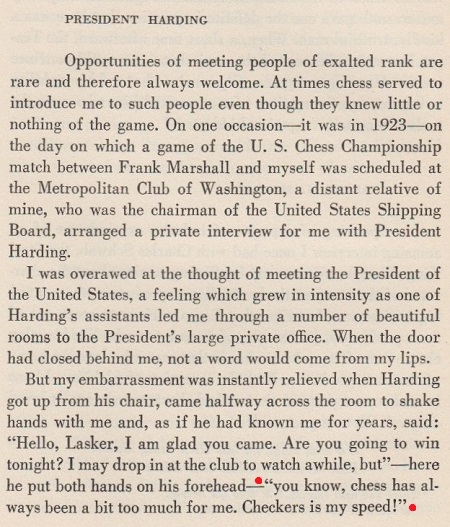
The only game of the Marshall v Lasker match that was played in Washington was the 15th, on 30 April and 1 May 1923 (American Chess Bulletin, May-June 1923, page 93). President Harding died three months later.
An inscription in one of our copies of Lasker’s book:
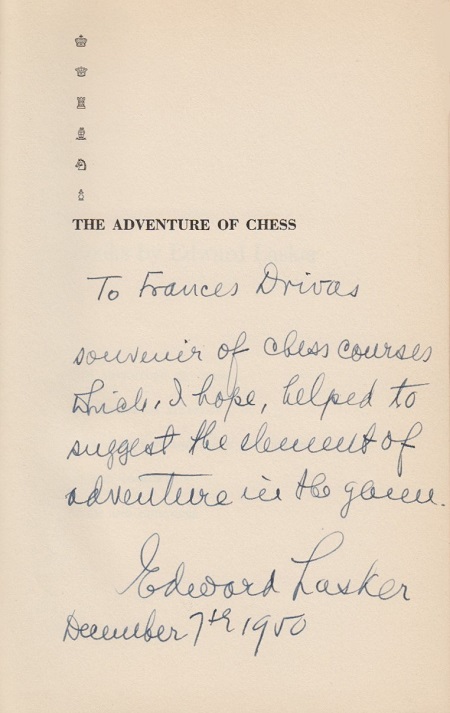
(9663)
From page 45 of The Adventure of Chess by Edward Lasker (New York, 1950), in a paragraph concerning the Soviet Union:
‘Ten thousand women recently took part in preliminaries organized for the purpose of qualifying competitors for the national women’s title.’
Although Lasker used the word ‘recently’, the following is on page 239 of the Australasian Chess Review, 10 September 1936:
‘Over ten thousand women are competing in the eliminating sections of the women’s chess championship of the USSR. Our readers will have got so used to these staggering chess figures from Russia that comment is not required.’
Even so, corroboration is always welcome.
(9876)
C.N. 3779 (see too Reviewing Chess Books) quoted a remark by Fred Reinfeld on page 96 of Chess Review, March 1951:
‘If a reviewer spends all of an hour nowadays reading the book he is supposed to be reviewing, he feels that he has done more than his duty. This is particularly unfortunate in the field of chess, in which it often requires years to write a good book.’
That was the first paragraph of his highly favourable review of Chess Secrets I Learned from the Masters by Edward Lasker (New York, 1951). The second paragraph:
‘Chess Secrets must have taken many years to write, and the events which it chronicles took some 40-odd years to live through. I consider myself fortunate to have had the opportunity of reading this book three times: in manuscript, in galley proofs and in page proofs. Each reading was an enjoyable experience.’
Reinfeld’s three readings did not save the book from its many historical errors, some of which have been mentioned in C.N., but the qualities of Chess Secrets are not in dispute.
On page 40 of Chess World, February 1952, C.J.S. Purdy wrote:
‘This excellent book is by the international master Edward Lasker, but the best of the many good things in it are by Emanuel Lasker. We mean things Emanuel, in his lifetime, said to Edward and from which Edward profited in his own games, and put in this book. The two were unrelated but great friends.
Edward Lasker is one of the few chess writers who have the faculty of writing well and entertainingly; he lapses but rarely into journalism.
... Some people like their expositions of chess to be systematic. That is important in mathematics or science but much less so in chess, which is more art than science. This book, with its sugar-coating of gossip, will teach most students more than many orthodox text-books. Drudgery should be avoided.
... The reviewer can claim to have derived more entertainment from Chess Secrets than any other chess book, and in our view there is not much to beat it for instruction, either.’
On page 133 of the September-October 1967 Chess World Purdy referred back to his review and added:
‘People picking it up casually would mistake it for a book of gossip about the masters, which it partly is. They overlook that it contains 75 superbly annotated games by one of the best chess writers and annotators of all time. Each one is a work of art.’
(9950)
Page 180 of the November 1921 American Chess Bulletin:
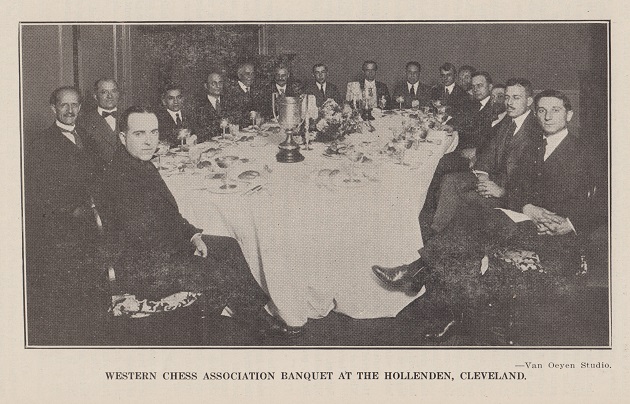
The key on the following page:
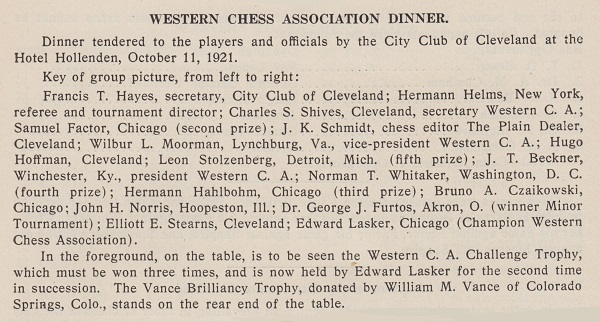
Larger version of the photograph
The tournament report on page 177 began:
‘For the fifth time in his career, Edward Lasker of Chicago, who in turn has been the champion of London, New York and Chicago, holds the proud title of champion of the Western Chess Association in consequence of his victory in the tournament held in connection with the annual meeting of that organization at the City Club of Cleveland in the Hotel Hollenden, Cleveland, O., from 5 to 13 October, inclusive.’
The event naturally had nothing to do with the US championship, a title held by F.J. Marshall from 1909 to 1936 and never won by Lasker. However, page 90 of The Rookie by Stephen Moss (London, 2016) refers to ‘Edward Lasker, a five-times US champion’.
After the Western Chess Association tournament, Lasker challenged Marshall for the US championship. His letter, dated 30 October 1921, was published on page 187 of the November 1921 American Chess Bulletin:
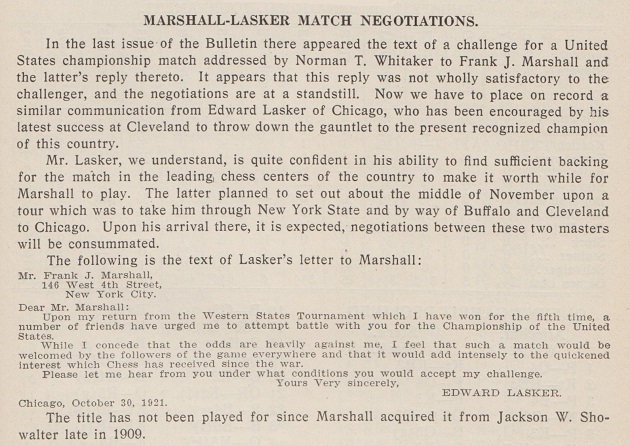
(10134)
A paperback edition of The Rookie by Stephen Moss has been published recently. A full page of quotes from reviews of last year’s first edition has been added, but there is no correction of the obvious mistake pointed out in C.N. 10134: page 90 still describes Edward Lasker as ‘a five-times US champion’.
(10568)
‘The development of the idea that playing chess is self-justifying ran parallel to or perhaps was an offshoot of the development of the idea of art for art’s sake. It reached its epitome at the end of the nineteenth century in the formula of Ernst Cassirer: “What chess has in common with science and fine art is its utter uselessness.”’
That comes from pages 52-53 of Crescendo of the Virtuoso by Paul Metzner (Berkeley and Los Angeles, 1998). An endnote reference 87 invites the reader to turn to page 308 for the source of the Cassirer quote. Will it be a weighty philosophical tome from the late nineteenth century? No:
Reinfeld also gave the Cassirer quote, again without a source, on page 287 of The Joys of Chess (New York, 1961).
In reality, there was nothing weighty about Cassirer’s remark. From pages 37-38 of Chess for Fun & Chess for Blood by Edward Lasker (Philadelphia, 1942):
‘Ernst Cassirer once said to me jokingly that what chess has in common with science and fine art is its utter uselessness. I am sure I discerned a note of praise in this remark which was not unconscious. If one were to condemn chess just because it is useless in the utilitarian sense of the word, one might, on the same basis, reject all but commercial art and many branches of higher mathematics which can hardly have any practical application.’
Pages 15-18 of the book reproduced a letter from Cassirer to Lasker which evinced a deep love of the game.
On pages 27-28 of Chess Secrets I Learned from the Masters (New York, 1951) Edward Lasker related his meetings with Cassirer and Emanuel Lasker, during which the latter’s philosophy was discussed.
(10160)
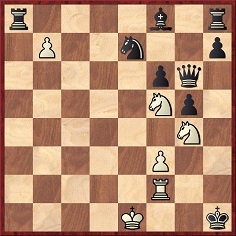
White to move and mate in two
One of our feature articles on the Laws of Chess mentioned that the ‘International Chess Code’ was published, inter alia, on pages 207-224 of Chess for Fun & Chess for Blood by Edward Lasker (Philadelphia, 1942). An extract from the provisions on castling (pages 212-213):
‘The king can be moved to a square adjoining the square he occupies except in the case of castling, which is a combined move of the K and the R, but counts as one move, in which first the K, occupying his own square, is placed on one of the two nearest squares of the same color as his own in the same rank and then the R, towards which the K has been moved, is placed on the next square on the further side of the moved K. Castling is not permitted (a) when either the K or R has been moved previously; (b) when any square between the K and the R is occupied by a man; (c) if the K be in check; or (d) if castling would cause the K to pass over, or occupy, any square on which he would be in check.’
The position shown above was presented by Jack Straley Battell on page 33 of the February 1955 Chess Review:
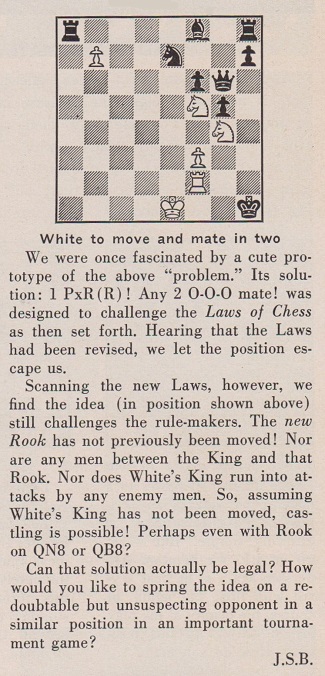
Where did the problem originate?
(10198)
The new text of the Laws of Chess passed by FIDE’s Congress in Schaffhausen in 1953 was given on pages 273-293 of the British Chess Federation’s Year Book 1953-1954 (Leeds, 1953). Below is an extract from the section regarding castling, on page 277:
‘Castling is a move of the king and a rook, reckoned as a single move (of the king), which must be carried out in the following manner: The king is transferred from its original square to either one of the nearest squares of the same colour in the same rank; then that rook towards which the king has been moved is transferred over the king to the square which the king has just crossed.’
Page 279 stated that ‘a move is completed ...’
‘... In the case of castling, when the player’s hand has quitted the rook on the square crossed by the king; when the player’s hand has quitted the king the move is still not yet completed, but the player no longer has the right to make any other move except castling.’
(10218)
From Chess and Christmas:
Our collection has this card sent by Edward Lasker to the Morphy authority David Lawson:
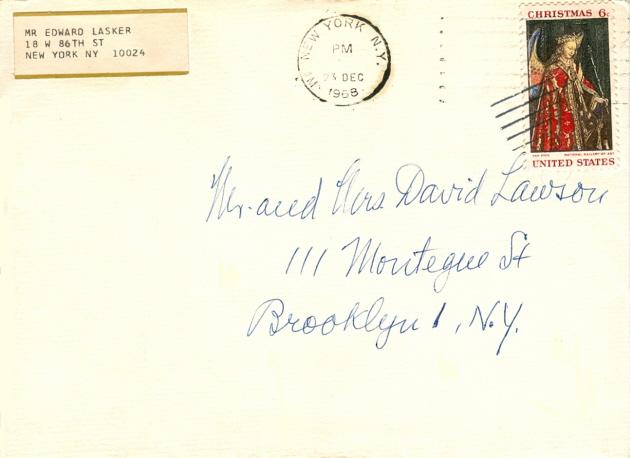
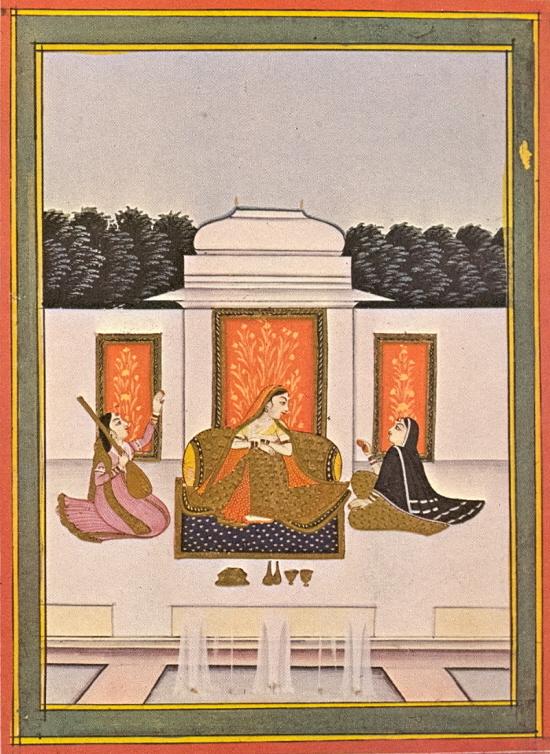
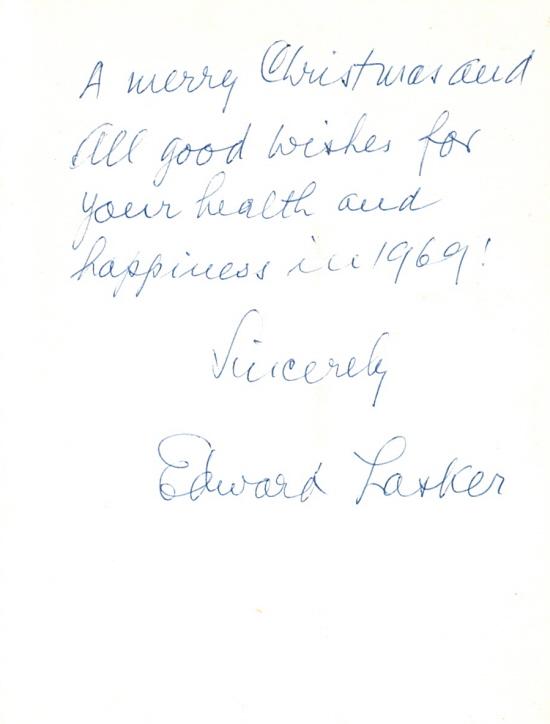
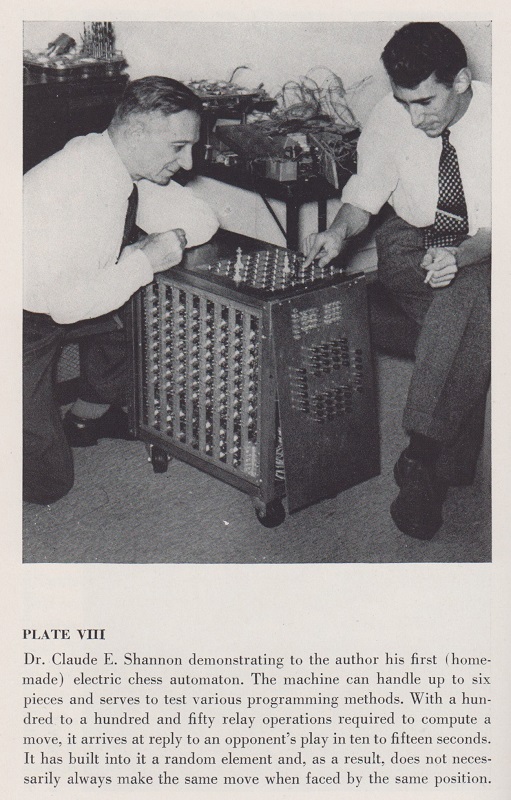
The Adventure of Chess by Edward Lasker (New York, 1950), opposite page 201
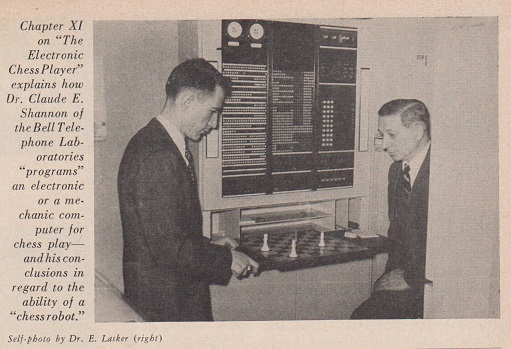
Chess Review, January 1951, page 13.
(10324)
An article ‘Experiments in Chess on Electronic Computing Machines’ by P. Stein and S. Ulam on pages 13-16 of the January 1957 Chess Review was introduced by Edward Lasker and ended with three games of ‘6x6 chess’. For example:
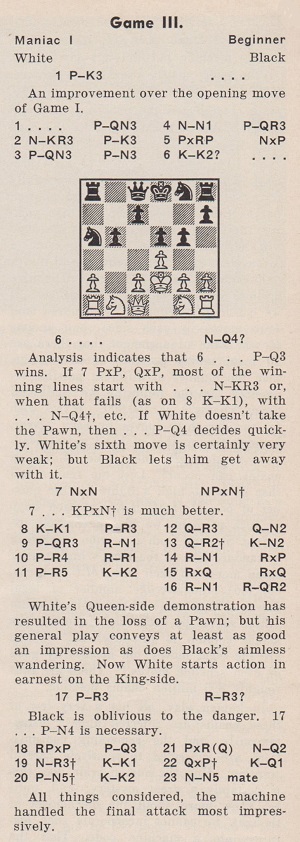
The three games, together with a summary of the rules, were published in the entry on Los Alamos Chess on pages 175-176 of The Encyclopedia of Chess Variants by D.B. Pritchard (Godalming, 1994).
(10325)
See Chess and Computers.
From page 226 of The Tao of Chess by Peter Kurzdorfer (Avon, 2004):
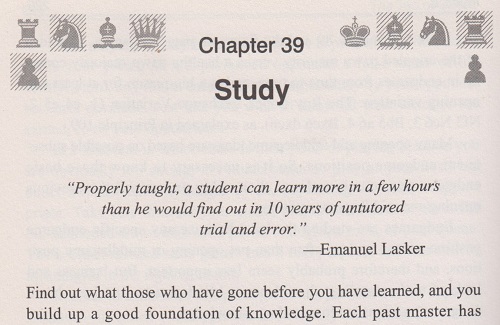
If Mr Kurzdorfer had found out what those who had gone before him had learned, he would have ascribed the quotation to Edward, not Emanuel, Lasker.
Firstly, a snippet from page 280 of Irving Chernev’s The Chess Companion:

However, on the inside front cover of Chess Review, January 1953, Chernev had correctly attributed the observation to ‘Ed. Lasker’.
The relevant passage was on page 232 of The Adventure of Chess by Edward Lasker (New York, 1950):
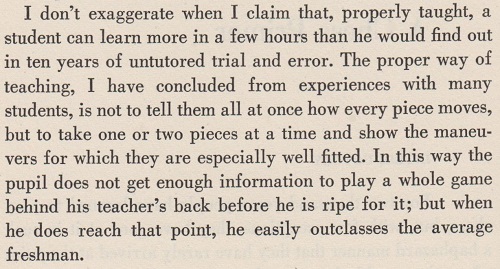
(10356)
Two books by Edward Lasker quoted a conversation with Janowsky in Berlin in 1910, at the time of the latter’s world title match against Emanuel Lasker.
From page 101 of The Adventure of Chess (New York, 1950):
‘Instead of admitting that he spent his nights at roulette, he said to me one day: “I don’t think I will win a game in this match. Lasker plays too stupidly for me to look at the board with any interest.”’
From page 115 of Chess Secrets I Learned from the Masters (New York, 1951):
‘After losing the first three games of the match, he said to me: “Your namesake plays such stupid chess that I simply cannot look at the board while he is thinking. I am afraid I shan’t do well in this match at all.”’
Edward Lasker’s statements on chess history require caution. For example, page 101 of The Adventure of Chess placed both of the longer Lasker v Janowsky matches in Berlin. On that point, page 88 of Chess Secrets I Learned from the Masters was correct (the former ‘took place in Paris in the fall of 1909’) but wrongly asserted that it was for the world title.
(11155)
See Lasker v Janowsky, Paris, 1909.
Throughout Chess Secrets I Learned from the Masters Edward Lasker used the spelling ‘Nimzóvich’, indicating stress on the second syllable. On page 241 of the August 1947 BCM Jacques Mieses referred to ‘Aron Niemzowitsch – four syllables with the accent on the last but one, thus: Ni-em-zó-witsch After 1920, however, he called himself willy-nilly Nimzowitsch’.
The pronunciation ‘Nimzó-Indian’ could be regarded as the logical consequence.
(11156)
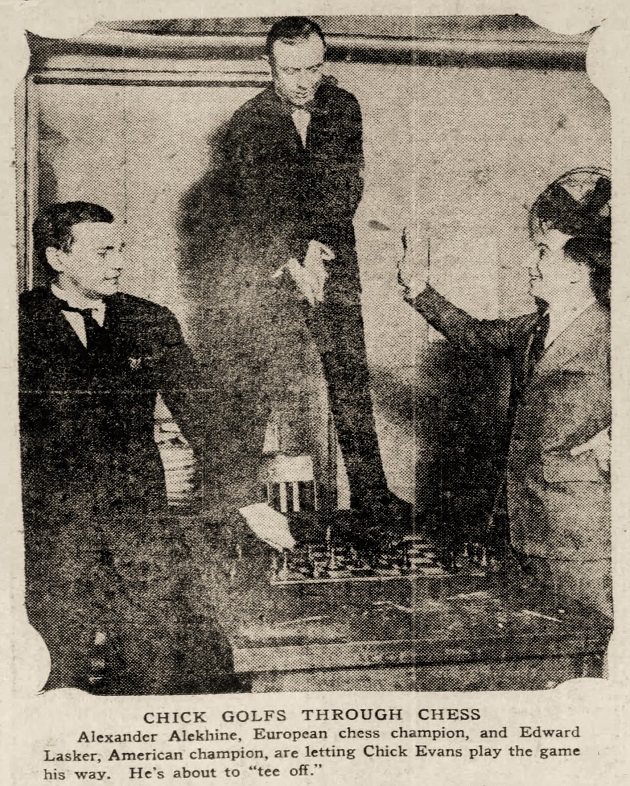
Philadelphia Inquirer, 9 February 1924, page 15
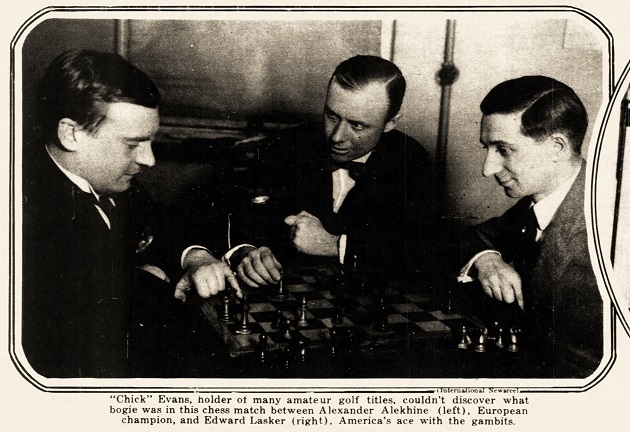
(11301)
A ‘tidied up’ version of the photograph on page 2 of the Pictorial News section of the Courier-Journal, 24 February 1924:
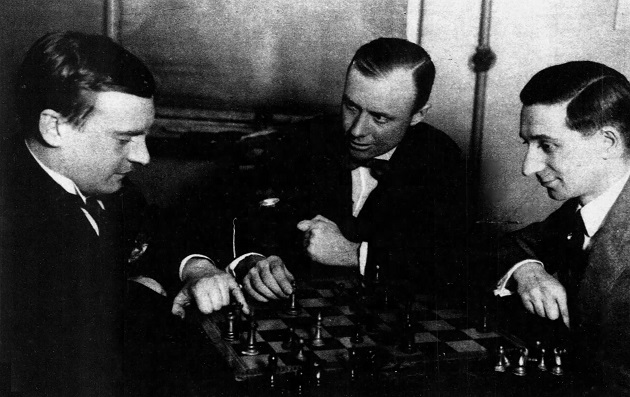
Alexander Alekhine, Chick Evans, Edward Lasker
(11306)
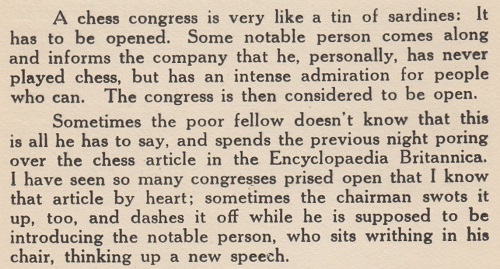
“Among These Mates” by Chielamangus (Sydney, 1939), page 58
On pages 387-388 of Chess Secrets I Learned from the Masters (New York, 1951) Edward Lasker referred to his attendance in 1947 at the inauguration of the Capablanca Chess Club in Havana and the speech by the Cuban President, Ramón Grau San Martín:
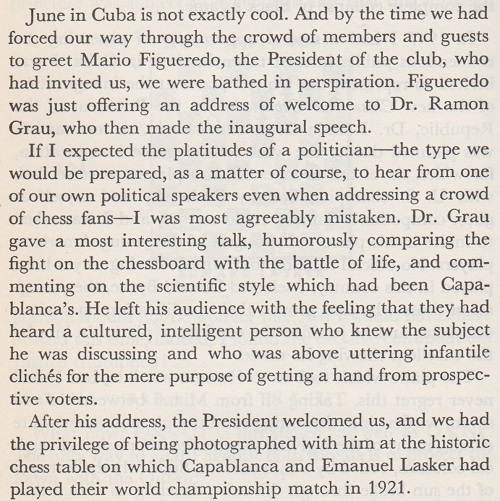
We seek a detailed report on the President’s speech.
(11452)
From page 102 of Chess Memoirs by Joseph Platz (Coraopolis, 1979), in a section on Edward Lasker:
‘Martha Lasker, Emanuel’s wife, did not care too much for Edward and made no bones about it. She felt that Edward took undue advantage of the fact that his name was Lasker. In fact, in Germany, he had published a book under the name Dr E. Lasker, and that induced a book critic to write: “Another great book by the famous world champion”.’
We are aware of no grounds for the accusation. Two title pages:
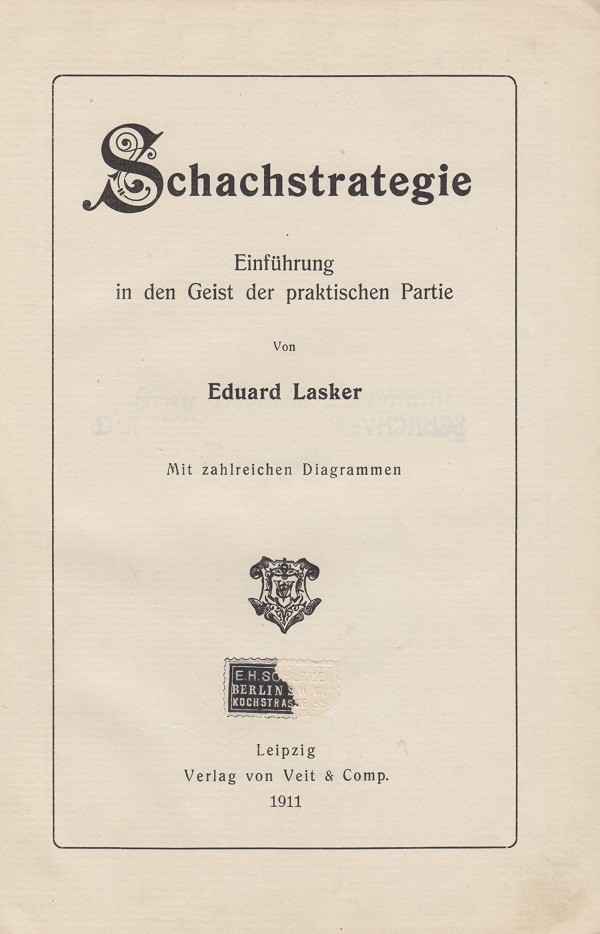
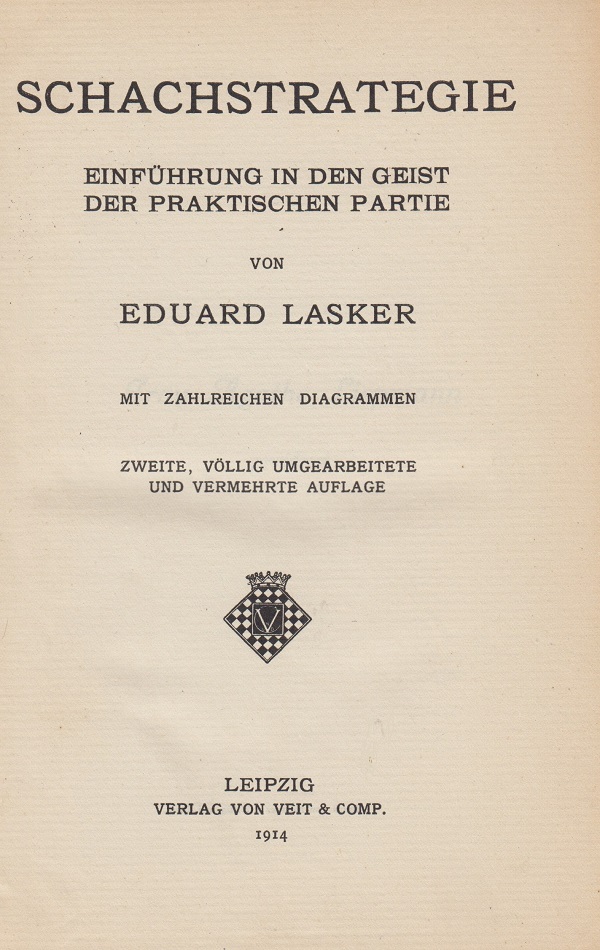
(11683)
From Where Did They Live?
65 Belsize Park Gardens, London NW, England (BCM, October 1913, page 403).
1004 East Forty-second Place, Chicago, IL, USA (American Chess Bulletin, May-June 1918, page 106).
1517 East 61st Street, Chicago, USA (Ranneforths Schach-Kalender, 1922, page 109).
5215 Cornell Avenue, Chicago, USA (Ranneforths Schachkalender, 1925, page 154).
28 West 85th Street, New York, USA (Ranneforths Schach-Kalender, 1930, page 71).
18 W 86th Street, New York, NY 10024, USA (1968 greetings card [see above]).
To the Archives
for other feature articles.
Copyright Edward Winter. All rights reserved.